Cam Smith shortens driver length at the U.S. Open. Here’s why it helped

Change Text Size
Nearly two years after DeChambeau’s announcement, the driver length craze has mostly fizzled out. In fact, some players have even gone the other direction, finding shorter driver lengths to be more beneficial to overall performance.
Case in point, PLAYERS champion Cameron Smith has shortened his driver by a half-inch for this week’s U.S. Open at The Country Club in Brookline, Massachusetts.
Smith already has two PGA TOUR wins under his belt this year and ranks fifth in the FedExCup but in his last few starts, he admits his driver performance has hit the skids.
“I think the last couple of weeks the driver has got me a little bit in trouble,” Smith said in a press conference at the U.S. Open. “Haven't hit as many fairways as I would like, and the rough the last couple of weeks has been pretty brutal, as well. So lots of chopping out and practicing my wedges for this week, so hopefully I can hit some more fairways and make some more birdies.”
That in mind, ahead of this week, Smith worked with his club fitter and Titleist tour rep J.J. Van Wezenbeeck to conduct driver testing in hopes of tightening up his driver game.
In the last few years, Smith has been using a 45-inch driver build. Most recently, he’s opted for a 10-degree Titleist TSi3 driver equipped with a Fujikura Ventus TR Blue 6X shaft.
Looking back to previous years, prior to using a 45-inch driver, Smith used to play with a driver that measured 44.5 inches. When current issues with his 45-inch driver came to the forefront – he was struggling with his dispersion and center contact – Smith told Van Wezenbeeck he wanted to try a 44.5-inch driver again.
For Van Wezenbeeck, cutting a half-inch off of a driver shaft means that weight has to be added back into the head in order to not throw off the swing weight of the club. After being properly weighted in the Titleist Tour Truck, the duo took to the practice range at the U.S. Open to conduct testing.
With his previous 45-inch TSi3 driver setup, Smith was struggling to find control over his ball flight, and he was missing the center of the face too often.
The 44.5-inch driver setup seems to have fixed those issues.
“We looked at strike pattern locations (with the shorter driver), and we found it tightened it up a little bit,” Van Wezenbeeck told GolfWRX. “He’s back to working it both directions off the tee, so centering the strike was helping.”
All things being equal, a shorter driver will tend to reduce swing speed, which could lead to a distance loss. The goal when making driver changes is rarely to hit the ball shorter, but Smith was actually finding that he wasn’t losing ball speed despite the shorter build.
“It can potentially lower swing speed because of the shorter shaft, but what we find with players is if you can control the strike location and it’s more centered, the athlete has more freedom,” Van Wezenbeeck explained. “So we weren’t seeing any ball speed losses. That was the thing, even though we were shorter, we didn’t see a ball speed loss.”
In the end, Smith found the new 44.5-inch TSi3 driver setup to provide more consistent strikes, more control over trajectory, and no loss in distance.
For amateur golfers, there’s an important lesson here. The goal when looking for the right driver setup is to improve consistency of center contact; most times, that’s more important than using a driver that you can simply swing harder.

Revealing the Average Driver Length on the PGA Tour
Have you ever wondered what the average driver length is on the PGA Tour? In this section, we will dive into the fascinating world of professional golf and explore the average driver length used by the golfers on the PGA Tour.
Key Takeaways
- The average driver shaft length on the PGA Tour is approximately 44.75 inches.
- Longer shafts are not necessarily used to chase more distance, as drivers are already optimized for maximum yardage.
- Player preference plays a significant role in determining the driver length, with some variations observed among professionals.
- Exceptional cases like Rickie Fowler cutting down his driver shaft to 43.5 inches for improved accuracy have been seen.
- Shortening the driver shaft can lead to more fairways hit and eliminate wild misses for improved performance.
Understanding the Importance of Driver Length in Golf
Driver length is a crucial factor in a golfer’s game, especially on the competitive stage of the PGA Tour. The length of a driver’s shaft can significantly impact a player’s performance, affecting both accuracy and distance. Understanding the importance of driver length in golf can help players optimize their game and achieve better results on the course.
On the PGA Tour, the average driver shaft length is approximately 44.75 inches, although there is some variation depending on individual player preference. Contrary to popular belief, longer shafts are not necessarily used to chase more distance, as modern drivers are already optimized for maximum yardage. Instead, golfers often customize their driver length to suit their swing and achieve greater accuracy.
One notable exception to the average driver length is professional golfer Rickie Fowler. In order to improve his accuracy off the tee, Fowler cut down his driver shaft to 43.5 inches. This adjustment allowed him to hit more fairways and eliminate wild misses, ultimately leading to better overall performance. It’s important to note that shortening the shaft can also result in increased distance and ball speed for certain players.
While the standard retail driver length is around 45.5 inches, players have the option to customize their driver length for a more tailored fit. Shortening the shaft may require adding weight to maintain swing balance, but the benefits in terms of accuracy and control can outweigh any adjustments that need to be made. It is recommended that golfers work with a professional to test different shaft lengths and find the optimal fit for their game.
In Summary:
– Driver length is an essential aspect of a golfer’s game, particularly on the competitive stage of the PGA Tour. – The average driver shaft length on the PGA Tour is approximately 44.75 inches, with some variation based on player preference. – Shortening the driver shaft can lead to improved accuracy, more fairways hit, and reduced wild misses. – Custom options are available for shorter driver lengths, but it may require adding weight to maintain swing balance. – Professionals recommend testing different shaft lengths with the guidance of a professional to find the optimal fit for improved performance on the PGA Tour.
Driver length is just one of many factors that professional golfers consider when fine-tuning their game. By customizing their driver length to suit their swing and preferences, players can achieve better accuracy, control, and ultimately improve their performance on the challenging courses of the PGA Tour.
The Average Driver Length on the PGA Tour
According to statistics, the average driver length on the PGA Tour is approximately 44.75 inches. This measurement showcases the typical length observed among professional golfers on the tour, but it’s important to note that individual players may have their own preferences and variations in driver length. The average length provides insights into industry standards and can serve as a reference point for golfers looking to optimize their own game.
While longer shafts are not necessarily used to chase more distance, as drivers are already optimized for maximum yardage, there are exceptions to the average driver length. Take, for example, Rickie Fowler, who made the decision to cut down his driver to 43.5 inches for improved accuracy. This adjustment allowed him to find more fairways and eliminate wild misses, leading to overall better performance on the course.
Shortening the driver length can have various effects on a golfer’s game. In some cases, players have reported increases in distance and ball speed by opting for a shorter driver length. It’s worth noting that the standard retail driver length is around 45.5 inches, but custom options are available for those seeking shorter lengths.
Shortening the shaft of a driver may require adding weight to maintain swing balance. This customization is crucial to ensure that the club feels comfortable and performs optimally for each golfer. To find the optimal driver length, it is recommended to work with a professional who can provide guidance and help test different shaft lengths based on individual swing characteristics and preferences.
In conclusion, the average driver length on the PGA Tour is approximately 44.75 inches, but there is room for customization and personalization based on a golfer’s needs. By finding the right driver length, golfers can enhance their accuracy, distance, and overall performance on the course.
Factors Influencing Driver Length Preferences
Several factors come into play when professional golfers decide on their driver length for optimal performance. While the average driver shaft length on the PGA Tour is approximately 44.75 inches, individual preferences can vary. It’s crucial to find the right balance between distance and accuracy to achieve the best results on the course.
One of the key considerations is player comfort and control. Golfers often experiment with different driver lengths to find the one that suits their swing mechanics and allows them to consistently strike the ball with precision. This can help in reducing the risk of mishits or wayward shots, ultimately leading to more fairways hit and lower scores.
Another factor to consider is the potential impact on distance and ball speed. While longer shafts have traditionally been associated with greater distance, it’s not always the case. Some players have found that shortening their driver length actually improves their ability to generate power and maintain control, resulting in increased distance and ball speed. This highlights the need for individual customization and testing to find the optimal fit for each golfer.
It’s worth noting that cutting down the driver shaft may require additional modifications to maintain swing balance. Adding weight to the clubhead or adjusting shaft stiffness can help achieve the desired feel and performance. Custom options are available, allowing golfers to explore different shaft lengths and find the perfect combination for their game.
In conclusion, finding the optimal driver length involves considering multiple factors such as comfort, control, distance, and swing balance. Professional golfers must tailor their equipment to suit their individual needs and preferences. Testing different shaft lengths with the guidance of a professional can help ensure the driver length maximizes performance on the PGA Tour.
Exceptions to the Average: Case of Rickie Fowler
While the average driver length on the PGA Tour is around 44.75 inches, there are exceptions where players choose different lengths for specific reasons. One notable example is professional golfer Rickie Fowler, who has made adjustments to his driver length in order to improve accuracy.
Fowler decided to cut down his driver to 43.5 inches, shorter than the average length, to address accuracy issues in his game. By shortening the shaft, Fowler aimed to hit more fairways and eliminate wild misses. The results have been promising, as he has seen an improvement in his ability to find the fairway consistently.
It’s worth noting that shortening the driver length may not only improve accuracy but can also have positive effects on distance and ball speed. While drivers are optimized for maximum yardage, some players have experienced increased distance and ball speed by going shorter. This adjustment can be attributed to improved strike quality and better control over the clubhead.
For the average golfer, it’s important to recognize that the standard retail driver length is typically around 45.5 inches. However, custom options are available to accommodate shorter lengths, similar to what Rickie Fowler has chosen. Shortening the shaft may require adding weight to maintain the swing balance, but this customization can be done with the help of a professional.
In summary, while the average driver length on the PGA Tour remains around 44.75 inches, players like Rickie Fowler have shown that customized adjustments can bring notable benefits. Cutting down the driver length can lead to improved accuracy, more fairways hit, and potential increases in distance and ball speed. To find the optimal driver length, it’s advisable to work with a professional who can help customize and test different shaft lengths for individual players.
Benefits of Shortening the Driver Length
Shortening the driver length can provide various benefits to professional golfers, including improved accuracy and consistency. While drivers are already optimized for maximum yardage, cutting down the shaft can lead to more fairways hit and eliminate wild misses. In fact, some players have even experienced an increase in distance and ball speed by using a shorter driver length.
The average driver shaft length on the PGA Tour is approximately 44.75 inches, but there is some variation depending on player preference. However, the standard retail driver length is around 45.5 inches, indicating that custom options are available for those seeking shorter lengths.
When shortening the driver length, it’s important to consider swing balance. Adding weight to the clubhead or grip may be necessary to maintain the desired swing characteristics. Working with a professional can help golfers find the optimal driver length for their game, ensuring that the adjustments made will enhance performance rather than hinder it.
Table: Average Driver Lengths on the PGA Tour
As evidenced by players like Rickie Fowler, who cut down his driver to 43.5 inches for improved accuracy, customizing driver length can have a significant impact on a golfer’s game. It allows them to fine-tune their equipment to match their swing and personal preferences, ultimately leading to more consistent and reliable shots.
So, if you’re a professional golfer looking to gain an edge on the PGA Tour, don’t overlook the potential benefits of shortening your driver length. Consult with a knowledgeable professional, experiment with different shaft lengths, and discover the optimal fit for your game. By making this adjustment, you may just find yourself hitting more fairways and achieving greater accuracy on the course.
Customize Your Driver Length
Professional golfers have the option to customize their driver length to suit their individual preferences and playing style. The average driver shaft length on the PGA Tour is approximately 44.75 inches, but players are not bound to this standard. Longer shafts are not necessarily used to chase more distance, as drivers are already optimized for maximum yardage. However, there are exceptions to the average driver length on the PGA Tour , with players like Rickie Fowler choosing to cut down their driver shaft for improved accuracy.
By shortening the driver length, players like Fowler have seen an increase in fairways hit and a reduction in wild misses. In some cases, going shorter has even resulted in improved distance and ball speed. The standard retail driver length is around 45.5 inches, but custom options are available for those who prefer a shorter shaft.
It’s important to note that shortening the shaft may require adding weight to maintain swing balance. The optimal driver length can vary from player to player, and it is recommended to test different shaft lengths with the guidance of a professional. They can assess your swing characteristics and help determine the perfect customized driver length that will enhance your performance on the PGA Tour.
Ultimately, finding the optimal driver length is a personal journey for each golfer. Customizing the length can provide you with a club that feels comfortable, promotes better accuracy, and potentially enhances your overall performance on the PGA Tour. So, if you’re looking to take your game to the next level, consider exploring the option of customizing your driver length with the help of a professional.
Effects of Shortened Driver Length on Distance and Ball Speed
Contrary to common belief, shortening the driver length may not necessarily result in a decrease in distance or ball speed. In fact, there are cases where professional golfers have experienced positive improvements by opting for a shorter driver shaft on the PGA Tour.
Notable exceptions, such as Rickie Fowler, have made adjustments to their driver length for enhanced accuracy. Fowler cut down his driver to 43.5 inches, which led to more fairways hit and eliminated wild misses. This customization allowed him to maintain control over his shots, ultimately leading to improved performance on the course.
While longer driver shafts are often associated with chasing more distance, it’s important to note that modern drivers are already optimized to provide maximum yardage. The standard retail driver length is around 45.5 inches, but custom options are available for shorter lengths.
“Shortening the driver length can lead to more fairways hit and eliminate wild misses.” – Rickie Fowler
Shortening the shaft may require adding weight to maintain swing balance. However, it’s recommended that professional golfers test different shaft lengths with the guidance of a professional to find the optimal fit for their game. This individualized approach ensures that players can maximize both accuracy and distance, ultimately improving their performance on the PGA Tour.
Finding the Optimal Driver Length
Testing different driver lengths with the help of a professional can help golfers find the optimal fit for their swing and performance. The average driver shaft length on the PGA Tour is approximately 44.75 inches, but there is some variation among players based on individual preferences.
Longer shafts are not necessarily used to chase more distance, as drivers are already optimized for maximum yardage. However, there are exceptions to this trend. For example, Rickie Fowler cut down his driver length to 43.5 inches in pursuit of improved accuracy. By shortening the shaft, Fowler was able to hit more fairways and eliminate wild misses.
Interestingly, cutting down the driver shaft can sometimes lead to an increase in both distance and ball speed. While this may seem counterintuitive, it highlights the importance of finding the right driver length for your game. It’s worth noting that the standard retail driver length is around 45.5 inches, but there are custom options available for shorter lengths.
Importance of Swing Balance and Customization
Shortening the driver length may require adding weight to maintain swing balance. This ensures that the club feels comfortable and stable during the swing, allowing for consistent and accurate ball striking. When considering customization options for driver length, it’s advisable to seek professional guidance.
“Cutting down the driver length can lead to more fairways hit and eliminate wild misses.”
A professional golf club fitter can analyze your swing mechanics, ball flight tendencies, and overall goals to determine the ideal driver length for your specific needs. By working with a professional, you can ensure that the adjustments made to your driver length are tailored to maximize your performance on the PGA Tour.
Considerations for Shaft Weight and Swing Balance
Shortening the driver length may require adding weight to the club to maintain swing balance and optimize performance. While reducing the driver’s length can enhance accuracy, it can also affect the club’s overall feel and performance. To compensate for the shortened shaft, golfers often choose to increase the weight of the clubhead or add weight to the grip end.
Adding weight to the clubhead can help maintain the swing’s natural balance and prevent it from becoming too light. This is especially important for players who rely on a certain tempo or rhythm in their swing. By adjusting the clubhead weight, golfers can ensure that their swing remains consistent and powerful even with a shorter driver length.
Similarly, adding weight to the grip end can also help with swing balance. This can be achieved by using a heavier grip or adding additional weight to the grip itself. By doing so, golfers can maintain control and stability throughout the swing, ensuring optimum contact and ball flight.
It is important for golfers to test out different weight configurations to find the optimal balance for their game. Working with a professional club fitter or a trusted instructor can provide valuable guidance and ensure that the adjustments are tailored to the golfer’s specific needs and swing mechanics. By taking into account factors such as swing tempo, rhythm, and desired shot shape, golfers can customize their driver length while maintaining swing balance and optimizing their performance on the PGA Tour.
Seek Professional Guidance for Driver Length Customization
To ensure the best results, professional golfers should seek the expertise of a golf professional when making adjustments to their driver length. While it may be tempting to experiment with different shaft lengths on your own, consulting a professional can provide valuable insights and prevent potential issues that may arise from improper customization. By working with a knowledgeable instructor or club fitter, you can optimize your driver length to suit your individual swing characteristics and enhance your overall performance on the PGA Tour.
Customizing driver length involves a delicate balance between achieving maximum distance and maintaining control and accuracy. A golf professional can analyze your swing mechanics, launch conditions, and ball flight patterns to determine the ideal driver length for your game. They can guide you through the process of finding the perfect balance between maximizing your potential distance and maintaining consistency off the tee.
Through a comprehensive fitting session, a golf professional can help you test various driver lengths and assess the resulting impact on your ball speed, distance, dispersion, and overall performance. This data-driven approach ensures that you are making informed decisions based on objective measurements rather than relying on guesswork or assumptions.
In addition to driver length customization, a golf professional can also assist you in considering other factors that may influence your driver performance, such as shaft weight and swing balance. By taking a holistic approach to club fitting, you can fine-tune every aspect of your equipment to optimize your game and achieve your full potential on the PGA Tour.
The Impact of Driver Length on PGA Tour Performance
Driver length plays a crucial role in the performance of professional golfers on the PGA Tour, with customization options available to optimize accuracy and consistency. The average driver shaft length on the PGA Tour is approximately 44.75 inches, although individual player preferences may vary. It’s important to note that longer shafts are not necessarily used to chase more distance, as modern drivers are already designed to maximize yardage.
One notable exception to the average driver length is Rickie Fowler, who cut down his driver to 43.5 inches for improved accuracy. By shortening the shaft, Fowler was able to hit more fairways and eliminate wild misses, ultimately enhancing his overall performance. Interestingly, some golfers have even experienced an increase in distance and ball speed by opting for a shorter driver length.
While the standard retail driver length is around 45.5 inches, custom options are available for those who prefer a shorter shaft. Shortening the driver length may require adding weight to maintain swing balance, which is an important consideration for optimal performance. To find the perfect fit, it is recommended that professional golfers work with a knowledgeable expert who can guide them through testing different shaft lengths and ensuring the best outcome for their game on the PGA Tour.
What is the average driver length on the PGA Tour?
The average driver shaft length on the PGA Tour is approximately 44.75 inches, with some variation depending on player preference.
Why do golfers use longer driver shafts?
Longer shafts are not necessarily used to chase more distance, as drivers are already optimized for maximum yardage. However, some players may prefer longer shafts for personal preference or swing characteristics.
Are there exceptions to the average driver length on the PGA Tour?
Yes, some players, like Rickie Fowler, have cut down their driver shaft length for improved accuracy. Fowler’s driver length is 43.5 inches.
Can shortening the driver shaft improve accuracy?
Yes, cutting down the driver shaft can lead to more fairways hit and eliminate wild misses, resulting in improved accuracy.
Can shortening the driver shaft increase distance and ball speed?
In some cases, players have seen an increase in distance and ball speed by going shorter with the driver shaft.
What is the standard retail driver length?
The standard retail driver length is around 45.5 inches. However, custom options are available for shorter lengths.
Do I need to add weight when shortening the driver shaft?
Shortening the shaft may require adding weight to maintain swing balance. It is recommended to consult with a professional to ensure proper customization.
How can I find the optimal driver length for my game?
Testing different shaft lengths with a professional can help determine the optimal driver length that suits your swing and performance.
Source Links
- https://www.todays-golfer.com/features/equipment-features/2020/june/driver-shaft-length/
- https://golf.com/gear/drivers/average-driver-shaft-length-pga-tour-fully-equipped/?amp=1
- https://www.golfmonthly.com/features/the-game/optimum-driver-shaft-length-82330
Baron Cooke has been writing and editing for 7 years. He grew up with an aptitude for geometry, statistics, and dimensions. He has a BA in construction management and also has studied civil infrastructure, engineering, and measurements. He is the head writer of measuringknowhow.com
Leave a Reply Cancel reply
Your email address will not be published. Required fields are marked *
Save my name, email, and website in this browser for the next time I comment.

Driver Shaft Length: The Ultimate Guide
Key Takeaways
Driver Shaft Length affects your golf swing speed, accuracy, and distance. Key considerations include:
- Standard Lengths : Men's standard is 45 inches , women's is 44 inches .
- Ideal Length : Generally, 45-48 inches for men, 43-45 inches for women, adjusted based on height and swing speed.
- Longer Shafts : Increase swing speed and distance, but reduce accuracy.
- Shorter Shafts : Enhance control and accuracy.
- Professional Fitting : Recommended to determine the right length, considering individual physical traits and swing mechanics.
- Regulations : Maximum length for professionals is now 46 inches , not affecting recreational play.
Consult a professional club fitter to find your optimal shaft length for improved performance.

When it comes to golf club fitting, one of the most important factors is the length of the driver shaft. The length of the shaft can affect your swing speed, accuracy, and distance. Choosing the right length can make a significant difference in your game.
But how do you determine the right length for your driver shaft? In this ultimate guide, we will explore everything you need to know about driver shaft length. From the factors that affect the length to the pros and cons of different lengths, we’ll cover it all.
Let’s dive in and discover how to choose the perfect driver shaft length for you.
- 1) What’s the Standard Driver Length
- 2) What Is The Ideal Shaft Length?
- 3) Driver Shaft Length by Height Chart
- 4) How to Measure Your Driver Shaft Length?
- 5) Distance vs. Accuracy: Driver Shaft Length Balance
- 6) What Length Driver Do the Best Club Fitters Recommend for Most Golfers?
- 7) What Happens When You Cut Down a Driver?
- 8) How Long Are PGA Tour Professionals’ Drivers?
- 9) Restrictions of Shaft Length in Professional Golf
- 10) Does a Longer Shaft Mean More Distance?
- 11) What Works Best For You?
- 12) Final Thoughts
What’s the Standard Driver Length
When it comes to driver shaft length, standard length varies for men’s and women’s clubs. The typical length of a men’s driver shaft is around 45 inches, while for women, it is approximately 44 inches. However, these numbers may vary depending on an individual’s height, swing speed, swing weight , and other factors that can impact the club’s performance.
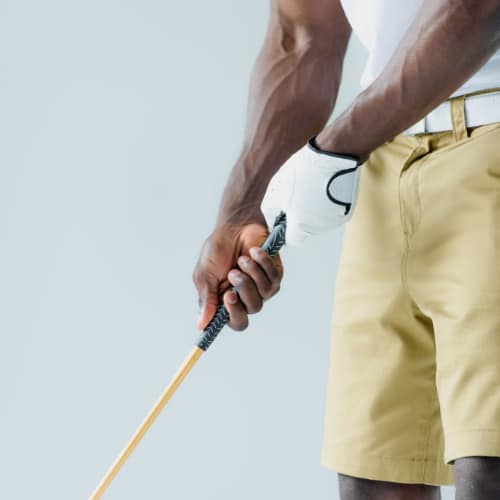
Driver shaft length has increased over the years for several reasons. First, as golf ball technology has advanced, the need for increased swing speed has become more apparent. A longer shaft allows for a faster swing, resulting in a higher ball speed and longer tee shots. Additionally, manufacturers have discovered that many golfers associate a longer shaft with the perception of power. This has prompted them to design clubs with a longer shaft length to attract buyers.
Since 2020, off-the-rack driver models from TaylorMade, Callaway, PING, and Titleist come with slightly varying shaft lengths. Here’s a quick table with a few examples to see the difference:
What Is The Ideal Shaft Length?
Your height, age, ball speed, and swing speed all play a role in determining the best shaft length for your game. Male golfers typically use longer shafts than female golfers due to the difference in their height and swing speed.
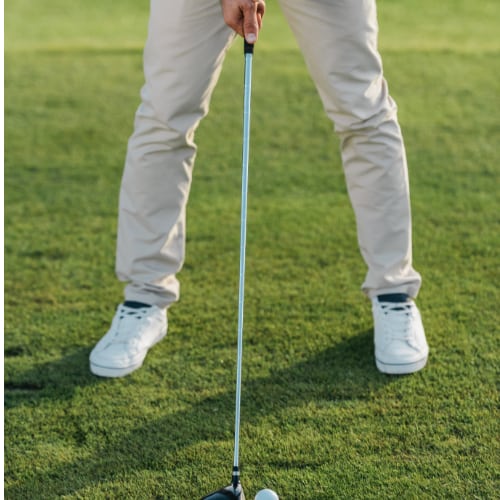
As a general guideline, the ideal driver shaft length for male golfers ranges from 45-48 inches, while female golfers often use a shaft length between 43-45 inches. However, keep in mind that these are just guidelines, and trying out different lengths and flexes (the club’s ability to bend during the swing) is crucial to finding the perfect fit.
A professional club fitter can assist in finding the right driver length for your game. They will take into account your swing action, club head speed, and other measurements such as floor-to-wrist measurements to determine the correct club length for your body.
Driver Shaft Length by Height Chart
To determine the recommended shaft length based on your height, golf club manufacturers use the Driver Shaft Length by Height Chart, which uses the player’s wrist-to-floor measurement to gauge the correct club length.
Let’s explore the different height categories and the corresponding recommended shaft length based on the chart.
Choosing the correct driver shaft length based on your height can have a significant impact on your swing speed, ball speed, and overall performance. Take the time to measure your wrist-to-floor and use the Driver Shaft Length by Height Chart to find your recommended shaft length. Women’s shafts are usually one inch shorter than men’s.
How to Measure Your Driver Shaft Length?
To accurately measure the length of your driver shaft, you should lay the driver flat on the ground with the clubhead pointing outwards. Take a measuring tape and measure from the end of the grip down to the heel of the club. This measurement will give you the length of your driver shaft.

It is important to note that the standard length for a ladies’ driver is typically an inch shorter than it is for men. This is because female golfers tend to be shorter in height, have less club head speed, and a slower swing speed. However, taller golfers, both male and female, may require a longer driver shaft.
It is also important to keep in mind the new local rule, issued by the USGA and R&A , that limits driver length to 46 inches (before, the limit was 48″). This rule was created to preserve the balance between skill and technology in the game of golf. A club longer than 46 inches may provide an unfair advantage and violate the rules of golf.
By measuring your driver shaft length, you can determine if a shorter or longer shaft is necessary for your swing.
Distance vs. Accuracy: Driver Shaft Length Balance
Distance and accuracy are both important in golf. Finding the right balance between the two is key to improving your game.

A longer shaft provides a larger arc during the swing, allowing the golfer to generate more speed and potentially hit the ball farther . However, it’s worth noting that longer shafts can also make it more challenging to strike the ball consistently in the center of the clubface, which may offset the potential distance gains.
Check Also: Hit It Long and Straight: Golf Drills & Tips to Elevate Your Driving Game
Generally, shorter shafts offer better control and can enhance accuracy. A shorter shaft provides more control over the clubhead throughout the swing, making it easier to square the face at impact. This can lead to more accurate shots and tighter dispersion patterns. Longer shafts, on the other hand, can be more challenging to control, especially for golfers with less consistent swings.
Ultimately, it’s important to find the right balance between distance and accuracy. A professional club fitter can help you determine the ideal shaft length for your swing and player profile. Additionally, other factors like shaft flex, weight, and overall clubhead design also influence performance.
What Length Driver Do the Best Club Fitters Recommend for Most Golfers?
The best club fitters recommend that most golfers use a driver at or near standard length. Research has shown that the average golfer performs best with a standard-length driver shaft. However, if you are significantly shorter or taller than the average height, a non-standard length shaft may be necessary for optimal performance.
Professional club fitters take into account your swing speed, wrist-to-floor measurements, swing weight, and clubhead speed when determining the ideal driver shaft length for you.
Overall, the majority of golfers will benefit from using a standard-length driver shaft. Consult with a professional club fitter and take accurate measurements using a tape measure to ensure that you are using the correct club for your height and swing action.
What Happens When You Cut Down a Driver?
When you cut down a driver shaft, several things happen. The swing weight of the club becomes lighter, and the overall stiffness of the shaft increases. The swing weight is important because it affects the balance of the club during the swing. Cutting down a shaft can cause the club to feel head-heavy, which could result in a slower swing.

To address the swing weight, you can add additional weights to the clubhead or grip to compensate for the loss of weight. Another option is to have the shaft tipped to make it stiffer and reduce the overall weight of the club.
How Long Are PGA Tour Professionals’ Drivers?
When it comes to driver shaft length, PGA Tour professionals typically use drivers between 44-46 inches long. This standard length allows for a good balance between swing speed and control. However, some players deviate from this norm, such as Rickie Fowler and Phil Mickelson, who prefer drivers with different lengths than the norm.
Fowler, known for his unorthodox swing, uses a driver that is 43.5″, while Mickelson has been known for using extra-long drivers of around 47.5 inches (and even used a 48″ driver to win the Kiawah Island, S.C. PGA Championship). Bryson DeChambeau is another pro golfer that uses 48″ long drivers.
Overall, while the majority of professionals use drivers between 44-46 inches, it’s ultimately about personal preference and finding the correct fit for your game.
Restrictions of Shaft Length in Professional Golf
As of January 2022, professional golf introduced restrictions on driver shaft length, limiting it to a maximum of 46 inches.
The new rule aims to cap the increase in swing speed that longer shafts offer, reducing the distance a golf ball travels off a tee shot.
However, this restriction won’t impact the majority of golfers who play recreationally, as the Rules of Golf still permit driver shaft lengths up to 48 inches.
While some players, like Phil Mickelson and Bryson DeChambeau, have expressed their resistance to the rule, most pros understand the rationale behind it.
Professional golfers invest a lot of time and money to perfect their swings and increase their performance. Yet, this rule will ensure a level playing field, preventing a golf ball from traveling excessive distances off the tee and promoting fairness and skill over sheer power.
So, unless you’re a high-level competitor concerned about the new restriction, there’s no need to worry about the length of your driver shaft.
Does a Longer Shaft Mean More Distance?
A longer driver shaft can potentially mean more distance, but it’s not a guarantee. The relationship between driver shaft length and distance is not linear, meaning that longer shafts won’t always result in longer shots. Your swing speed, timing, and the specific clubhead can all affect how much distance you get based on your driver shaft length.

A longer driver shaft can give you the following advantages:
- Potential for more distance on your tee shots.
- Longer shaft can also create more club head speed and ball speed.
- Potentially ideal for taller players, as shorter shafts can require uncomfortable setup positions.
However, it also has some disadvantages such as:
- Decreased accuracy due to the longer shaft’s difficult swing plane.
- Heavier shafts can increase swing weight and make it difficult to control shots.
- Extra-long shafts also reduce control in the form of shot accuracy.
What Works Best For You?
Professional club fitting is the first step in determining the best driver shaft length for you as it takes into account physical measurements (mentioned earlier).
A professional fitter can then match you to the specifications of a shaft, including length, flex, weight, and kick point (the area of the shaft that bends most during the swing), to optimize your swing speed, ball speed, and overall performance.
While taller golfers may require longer shaft lengths, the majority of golfers will benefit from a standard driver shaft.
So, if you’re wondering what’s best for you, seek the guidance of a professional club fitter who can help determine the ideal shaft length that suits your physical traits and skill set, and ultimately help you achieve a consistent game.
Final Thoughts
Finding the right driver shaft length is crucial in enhancing your game. The importance lies in the impact of your swing’s accuracy and distance. A shorter driver shaft can improve accuracy, while a longer one can increase distance.
Finding the best shaft length is a highly personalized process, as what works for one player won’t necessarily work for another. A fitting session is the best way to find a shaft length that falls in that sweet spot where good swing speeds and distances are achieved without compromising accuracy!
Feel free to leave a comment below if you have any questions or would like to share your experiences with driver shaft length.
Thanks for reading!
Jacob Jensen
Join The Conversation Cancel reply
Save my name, email, and website in this browser for the next time I comment.
You May Also Like

“90% of driver shafts are too long”
Published: 22 June 2020 Last updated: 31 January 2024

Driver shafts keep getting longer - but could be making golf harder
Is your golf driver shaft too long for you?
What length is your driver shaft? For most golfers, the answer is “no idea”, “a bit longer than my 3-wood” or “not quite long enough to get me out of that bush when I’m using it to measure where I’m allowed to drop”. And why would you know or care? They’re all pretty much the same, right?
RELATED: Best Golf Drivers
But what if we told you that the driver in your bag now is probably two, three or even four inches longer than the one you had 15 years ago?
And what if we told you that extra length could be making it harder for you to hit the ball solidly, causing you to miss more fairways, and possibly even costing you distance off the tee?
And, finally, have you ever wondered why the best players on the planet are using shafts that are shorter than the ones being used by most amateurs?
Related: Most Forgiving Drivers
“I’d say 90 per cent of the drivers sold in the shops today are too long for most players,” says esteemed clubmaker Tom Wishon, of Wishon Golf . “The standard driver length of 45.5-46.5 inches offered by the majority of companies is too long for most golfers and will prevent them from achieving their maximum potential for distance and accuracy.”

Growing pains
Most driver shafts were around 43 inches until the early 1990s. The stock standard now is anywhere from 45.5 to 46.75 inches. There are two reasons for that growth. First, driver head size has increased significantly. Put a bigger head on the same length shaft you’re used to and it looks huge because your eye isn’t used to it, so shafts have increased to look more aesthetically pleasing.
And second – the biggest factor – the way we buy drivers has changed.
Related: Robot test – Which golf ball best suits your game?
Twenty years ago, you tried a few and bought the one you liked the best or the one that seemed to put you in the best positions. Nowadays, with the advent and proliferation of launch monitors, you can see exactly how far you’re hitting any driver you’re contemplating buying.
You can get instant feedback on launch angle, carry distance, total spin, sideways curvature and umpteen other metrics.
But there’s only one that the majority of golfers want to know: “How far did that go?”
Golfers are more obsessed than ever with hitting the ball as far as they can off the tee. And when a new driver can cost upwards of £450, you want as much yardage as possible for your money.
Related: Longest Driver 2020
Go and hit 50 balls using several different drivers with different shaft options and you’ll have a soft spot for the one that hit the longest drive of the day.
Manufacturers know a longer shaft gives them the best chance of achieving the “wow, that’s gone a mile” shot that stays in your mind and tempts you to part with your cash. That’s why shaft lengths keep getting longer – and we can’t blame manufacturers if that’s what we buy.

Driver distance sells golf clubs
“Longer driver shafts can create more clubhead speed, resulting in additional ball speed and overall distance gains,” says Custom Lab Golf founder Gavin Hay. “That’s why manufacturers have continually increased their standard spec driver shaft lengths over the years. They want their drivers to outperform other brands on raw distance.”
If longer shafts mean longer drives, isn’t this good news for us? Probably not, says Hay. “If a driver shaft is too long for the player, they can struggle to find the middle consistently. Off-centre hits not only drastically reduce ball speed and distance, but have a big impact on accuracy.”
Related: Best Drivers for Beginners and High Handicappers
So why do manufacturers sell shafts that are holding us back?
“The golf industry will generally go with whatever has worked well in testing,” says clubfitter and club builder Derek Murray of ForeGolf . “Under robot testing, you may find that if you take a longer shaft and hit it out of the screws, it could go five or eight yards further. So hit one right out of the middle with a long shaft and it will go far. But hit one out of the toe and you’ll lose eight or nine miles per hour in ball speed, which will end up costing you distance.”
Is it possible, then, that a shorter shaft may actually help you hit the ball further?
“We’ve seen a good number of players lose zero clubhead speed when testing a shaft that is an inch shorter than their current driver shaft, and they have found the centre of the clubface more consistently,” says Hay. “This improvement in strike generates higher ball speed, which is what creates distance.”
Related: Callaway’s 2021 Epic woods revealed and tested
If you’re not as good with a driver in your hands as the best players on the planet, why would you expect to be able to hit a driver with a longer shaft than they can?
“I very rarely build drivers that are 46 inches long,” says Murray, a former tour fitter who finds the vast majority of his clients are better off with a shaft that’s shorter than the manufacturer standard. “On tour I very rarely built drivers that were over 45 inches long.”
And Wishon agrees. “There’s a very good reason the average driver length on the PGA Tour is 44.5 inches and not 45.5 or 46.5.”

Putting it to the test
We built a Callaway Rogue driver in 43.5, 44.5 and 45.5 inches, with everything but the shaft length identical. The longer shaft did produce the highest average clubhead speed at 97.9mph, which also generated the highest ball speed at 146.1mph. But the resulting total distance of 273.7 yards was outdone by the 44.5-inch driver, which generated an average of 274.4 yards, despite clubhead speed being 1.3mph slower. The carry distance was four yards longer with the 44.5-inch shaft than its longer brother.
The reason? Strike. Our tester was able to find the middle of the clubface better with an inch taken off the shaft. The shortest shaft did produce the shortest drives, but only by three yards.
Dispersion was best with the shortest shaft and worst with the longest.
Related: Best Drivers 2020
The long and the short of it
It’s not a simple case of shorten your shaft and your handicap will fall. Your current length may be perfect for you. You may even need a longer one. But, as our experts and test have shown, a good number of golfers would benefit from a shorter shaft.
You may actually increase distance and there’s a good chance you’ll hit more fairways.
“Try shorter,” suggests Murray, who says that even half an inch can make a big difference – “45.5 is better than 46 in my experience, for the majority of golfers.”
How to find the right driver shaft length for YOU
1. There is no standard length
“There’s no golden length that is right for everyone, it’s totally individual,” says Derek Murray. “A lot will depend on timing, hand-eye co-ordination, individual ability and how you like a driver to feel. It’s not about your handicap, your swing speed or your height. The bottom line is that no one will know how a human golfer will react to something until they physically hit it.”
2. Test them out
“If you want to find out whether your driver is the optimum length to suit your swing, we highly recommend visiting an independent club fitter who uses a premium launch monitor, such as Trackman, GC2 or Flightscope,” says Gavin Hay. “Find someone who carries a wide selection of shafts at different lengths.”
3. Consider the whole package
If you’ve realised your driver shaft is too long for you, it’s not as simple as just chopping a few inches off your existing shaft.
“Be careful when changing shaft length as the swing weight will be affected which will result in a totally different feel,” says Hay. “If the shaft is shortened by an inch, you would need additional weight in the head to get the same swing weight. A good fitter can manage these variables for you to create a shaft that feels and performs the way you want.”
READ NEXT: How to choose the right fairway wood for your game
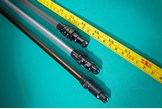
PGA Tour to adopt local rule to allow tournaments to limit driver length
- Earned Evans Scholarship to attend Indiana University

Golf's governing bodies announced a new local rule that will allow high-level tournaments to limit the length of drivers to 46 inches.
Called a Model Local Rule, it would go into effect Jan. 1, 2022. The PGA Tour said on Tuesday that it will adopt the rule, which does not apply to putters.
The United States Golf Association and R&A received feedback from players, equipment representatives and the various professional tours over the past several months before the announcement.
Bryson DeChambeau , who leads the PGA Tour in driving distance, has experimented with 48-inch drivers. Phil Mickelson , who won the PGA Championship using a 47½-inch driver, was critical of the potential move last month and took to Twitter again on Tuesday to voice his dissent.
"Really though, are the amateurs trying their best to govern the professional game the stupid ones?" Mickelson wrote on Twitter . "Or the professionals for letting them?"
Because it is a local rule, it would not prohibit amateurs from playing with a longer driver for handicap purposes. And it is unlikely regular competitions would invoke the rule; golf manufacturers do not mass-produce driver shafts longer than 46 inches.
There are numerous "local rules" in the rulebook that permit the game to be played in different ways at various levels. The tour often invokes a local rule called "preferred lies" or "lift, clean and place," when playing conditions are an issue. The professional tours (except for the PGA of America) invoke the "one-ball rule," which requires a player to use the same make and brand of ball throughout a round.
"We've worked closely with our industry partners to ensure the future for golf remains strong," said Mike Whan, the chief executive officer of the USGA, which along with the R&A announced the change. "Admittedly, this is not the 'answer' to the overall distance debate/issue but a simple solution for competitive events.
"It's important to note that it is not a 'Rule of Golf,' and as such, it is not mandated for the average, recreational golfer. Rather, this is an available tool for those running competitive events."
The PGA Tour said in a statement that it surveyed usage of clubs across all of its tours and "found a very small number of players either have used or are currently using clubs great than 46 inches" and that its player advisory council reviewed the subject before deciding to implement the local rule on Jan. 1.
BMW Championship
Castle Pines Golf Club
100 GREATEST HOLES

Equipment News
Golf’s ruling bodies take next step in limiting driver length

Regarding Bryson DeChambeau and Phil Mickelson and their lust for 48-inch drivers, golf’s ruling bodies have only one thing to say: Not so fast.
Technically, Tuesday’s announcement that the USGA and the R&A will reduce the maximum shaft length from 48 inches to 46 inches counts as a suggestion. It’s what’s called a Model Local Rule, which is generally designed to give tournament organizers or presumably any tour the right to implement a rule limiting driver length. But a spokespeople from the PGA Tour and the LPGA Tour confirmed its tours would implement the local rule in 2022, with the PGA Tour confirming Jan. 1, 2022 as the first date of enforcement. The USGA’s Thomas Pagel, senior managing director of governance, said the new limit will apply to all 14 USGA championships, also beginning in 2022.
“I think it’s very fair to say that this is a proactive measure,” he said of the new limit, which has been discussed and researched by the USGA and R&A since 2014 with a few stops and starts in between. It was announced as a proposal back in February.
“You saw a trend of more players experimenting, and I would say the governing bodies have been accused in the past of being reactive, and this was an opportunity for us to be proactive and cap something that is going to have a really small impact as far as the number of individuals. Had we waited, I think the change would have been that much harder.”
To be fair, Pagel said no one player’s use or success with a longer driver accelerated any decision. In other words, Mickelson’s win at the PGA Championship in May with a driver that measured 47.5 inches did not impact any decision on the shaft length rollback. Pagel called the model Local Rule "the least disruptive" approach, making it clear that the rule does not affect recreational golfers or any manufacturer interested in selling drivers longer than the new 46-inch limit.
“If there are recreational golfers that happen to be playing with something longer than 46 inches they can continue to play with that if they’d like,” Pagel said. “We felt it was appropriate to handle as a Model Local Rule now. It doesn’t mean that at some point in the future that it becomes a rule of golf, perhaps even a shorter length club is even considered. That’s nothing we’re discussing now, but it’s difficult to say never.”
Here's the statement from the PGA Tour on Tuesday acknowledging it would implement the rule: "After understanding the feedback received from the golf manufacturing community, we also undertook a survey of usage of clubs in use across the PGA Tour, PGA Tour Champions and the Korn Ferry Tour and found that a very small number of players either have used or are currently using clubs greater than 46 inches. The PGA Tour Player Advisory Council recently reviewed the subject and we have concluded that the PGA Tour will implement the Local Rule on Jan. 1, 2022."
The LPGA Tour didn't provide a definitive timeframe with its response: “[We] plan to implement the new rule at some point after the 2021 season. We have already started communication with the small number of players who may be affected by the change, to ensure they can make any necessary adjustments in a timely manner.”
Pagel said golf’s other professional tours and major championships “have been involved and engaged” with the decision on the new rule, and he expected them to announce their decisions shortly. While contacted by Golf Digest, the European Tour and Augusta National did not respond with comment. A PGA of America spokesperson said the organization would review the rule change and make an announcement before any 2022 PGA event. Several major manufacturers contacted by Golf Digest declined to offer a comment at this time.
For perspective, driver shaft lengths have increased over the last quarter century, both on the PGA Tour and in the marketplace. It was typical in the 1990s for drivers played on tour to be in the 43-inch range, and now the majority of tour players use a driver between 44.5 and 45.5 inches. In addition to Mickelson’s and DeChambeau’s interest in drivers at the current 48-inch limit, the LPGA’s Brooke Henderson also has played a 48-inch driver in the past. Almost all drivers being introduced by manufacturers now feature a shaft length of 45 to 45.75 inches.
Though some manufacturers have introduced drivers with shaft lengths longer than 46 inches, few have been successful. A decade ago, TaylorMade’s Burner Superfast 2.0 was 46.5 inches and was popular for a time before the company’s next model dropped back to a shorter shaft. Cobra introduced a lightweight 48-inch shaft in its Long Tom driver in 2011 that saw little traction.
RELATED: The latest golf boom has given the game a new set of problems
Of course, the evidence is not universal that a longer shaft will result in longer driving distance for every player. John Spitzer, the USGA’s managing director of equipment standards, said that multiple tests it has conducted show a three- to five-yard difference by going from 46 to 48 inches. “When we started looking at this, we only saw a couple of players on the tours using drivers that were over 46.5 inches,” Spitzer said. “And now we’re seeing an order of magnitude bigger than that.
“And they’re not going right from 46 to 48, but they are inching up, and as they inch up, eventually the manufacturers would start to offer clubs that were longer. So the timing was just right.”
John McPhee, professor of engineering at the University of Waterloo and a member of the Golf Digest Technical Panel, and his students have developed an optimized biomechanical/physics golf simulation that projects a six-yard gain in carry distance when an average human golfer goes from optimal launch conditions at 46 inches to optimal launch conditions at 48 inches, but his model showed a 10-yard gain in the optimals when going from 44 inches to 46 inches.
In a paper published on the subject submitted for the International Sports Engineering Association 2022 conference, McPhee and his student Spencer Ferguson conclude, “A rule to limit club length to 46 inches might help curb future distance gains at the elite level, but is unlikely to reduce current driving distances, as five of the most recent leaders in driving distance on the PGA Tour used drivers less than 46 inches in length.”
RELATED: Don't want to wait for new clubs? The used market is a better option than ever
For what it’s worth, according to PGA Tour statistics, Mickelson was about five yards shorter this year than he was in 2019 and his rank in strokes gained/off the tee still hasn’t moved into the top 150. Nevertheless, Mickelson recently went to social media to criticize the USGA for looking to roll back shaft length.
“What data was there to say that the driver length should be capped at 48 inches?” Mickelson said, shaking his head in a Twitter video posted last month. “What data is there that says it should go to 46 inches? We’re addressing the wrong problem, and we’re misreading the data yet again much like the grooves in 2010.”
Of course, Mickelson’s diatribe seems misplaced since he devotes much of it to arguing against the shaft length rule’s effect on average golfers, which the new rule would not impact in the least.
Pagel said the shaft-length rule addresses elite players now to avoid any further issues later. He said they do not see any evidence that long drivers are commonplace on tour or in the marketplace or among young developing golfers. But Mickelson and DeChambeau have been vocal about exploring the use of longer shafts. Pagel said the time to act was now.
“At the highest level, we were seeing the numbers were slowly creeping up,” he said. “With the swing speeds at that level and the abilities at that level, that’s where it would start to take off and that would be the start of a trend. Once the elite level players start to do something it will trickle down. How long it takes, it could have been 10 years before we would see a bunch of kids trying long drivers, but the point is let’s be proactive now.”
Pagel was quick to note that driver shaft length is not the governing bodies’ ultimate solution to the driving-distance question. New USGA CEO Mike Whan even went so far as to say in a statement, “Admittedly, this is not the ‘answer’ to the overall distance debate/issue, but rather a simple option for competitive events.”
The USGA and R&A are seeking comment on the broader topic of distance with a Nov. 2 deadline—so there is more to come, Pagel said. Among the topics being reviewed are a tightening of the tolerance zone for the measurement of springlike effect and new distance standards for measuring a golf ball’s optimal flight conditions. But the ideas go beyond those two proposals, which also were announced in February with the shaft-length rule.
“We’re in this critical discussion about the role that distance plays in the game and that’s ongoing,” he said. “Once we have that feedback we anticipate spending a significant period of time reviewing that and allowing it to inform whatever the next steps might be. People will say we move slow, but in this case I think it’s intentionally slow. We don’t want to act with haste, and I think that’s important for the industry.
"This model local rule by no means is intended to be a solution that helps to stop the cycle of increased hitting distances. We’re committed to what we said before and there will be solutions but this is not that solution. What they are, we’re not sure yet, but this is not it."
RELATED: 15 ways to be a faster golfer
“We’re committed to our desire to stop the cycle of increased hitting distances. We have the long-term health of the game in mind. How is the game healthy 20, 50, 100 years from now. That’s something we remain committed to. We know elite players can achieve distance increases through using a longer club, and as an industry as we go through the critical conversation about the long-term health of the game and what role distance plays with that, we just thought it was best to cap this now while we have the rest of that discussion.”

Driver Shaft Length Guide w/ Height Chart
To get to the driver shaft length chart, scroll down.
When it comes to shafts and drivers, golfers are constantly considering the length because it can significantly impact their game.
Is the length of the shaft is directly proportional to the distance the ball travels? Not exactly. While shaft length can influence distance, the relationship is not directly proportional and the explanation is more complex.
Increasing shaft length doesn’t automatically result in proportional distance gains. There’s a point of diminishing returns where additional length may not provide more distance and could negatively impact a player’s control. Longer shafts can be harder to control, potentially leading to off-center hits that reduce distance.
While some lower handicapped players might prefer longer shafts, there is a trade-off between hitting the ball farther and maintaining accuracy. Most experienced players rely on professional club fitting to determine their optimal shaft length.
The effect of shaft length on distance varies greatly among golfers, depending on their swing mechanics, strength, and timing. Each golfer has an optimal shaft length where they can maximize both distance and control.

Golf club manufacturers offer custom fittings precisely for this reason.
Most off-the-shelf drivers come with shafts around 45-46 inches, which is already considered long by many standards.
Starting in 2022 there is a new Model Local Rule MLR G-10 issued by the USGA and The R&A allowing those running professional or elite amateur golf competitions the option of limiting the maximum length of a golf club to 46 inches. Putters are excluded.
Many professional players, as well as lower handicappers, actually use driver shafts shorter than the standard retail length, often between 44-45 inches. These experienced players often prioritize control and consistency over maximum distance potential. On the other hand you have professional players such as Phil Mickelson who won the 2021 PGA Championship with a 47.9-inch or Bryson DeChambeau who also prefers much longer drivers. In 2020 he tested out a 48-inch driver just before the Masters. The use of 48-inch long drivers became the talk of the golf equipment world that year. Brooke Henderson is another pro who has also used a 48” driver. The new rule limiting the length of club shafts to 46″ really put a damper on exploring the potential for using these longer shafts.
But not all professional have drivers with long shafts. Cam Smith has actually moved from a 45″ driver back to a 44.5″ driver. According to GolfDigest in an 2024 article entitled, Why a shorter-length driver shaft can improve distance and accuracy , Will Zalatoris, who previously played a 46-inch driver, switched to a 44.5-inch driver this year. Tiger Woods’ driver has a 45″ shaft, while Justin Thomas’s driver is 45.625 inches.
This driver shaft length chart is only a suggestion.
The standard recommendation of how long a player’s driver shaft should be is based on their height and a wrist-to-floor measurement of the player.
Driver Shaft Length Chart By Height
The wrist-to-floor measurement is a crucial factor in determining the ideal golf club length for a player. This measurement helps ensure that the club isn’t excessively long or short, as improper length can significantly hinder a golfer’s performance.
The right club length, based on the wrist-to-floor measurement, allows a golfer to maintain optimal posture at address and throughout the swing, execute proper technique with greater ease, generate appropriate power and speed, achieve more consistent contact with the ball, and improve overall shot accuracy and distance control.
By using this measurement as a starting point, golfers can work with club fitters to fine-tune their equipment, taking into account other factors like swing characteristics and personal preferences.
This approach helps ensure that each player’s clubs are well-suited to their individual physique and playing style, setting the foundation for improved performance on the course.
The Importance of Driver Shaft Length

Club length is a critical factor in golf, influencing both comfort and performance on the course. Using clubs of improper length can lead to subtle yet significant adjustments in a player’s technique, often unconsciously developing into detrimental habits over time.
When playing with clubs that are too short, golfers may find themselves bending excessively, potentially straining their back and overcompensating by swinging with excessive force to achieve desired distances. In addition, a club that’s too short can limit power generation during the swing, decrease clubhead speed at impact, shorten the overall distance of shots, and potentially lead to a loss of accuracy due to compensating movements.
On the flip side, overly long clubs can force players into an unnaturally upright posture, compromising their ability to strike the ball accurately and consistently. It can create difficulties in maintaining proper posture throughout the swing, challenges in executing correct technique, inconsistencies in the swing motion, and reduced accuracy and control of shots.
The ideal club length enables golfers to adopt a natural, comfortable stance while allowing for optimal power transfer and control throughout the swing. This proper fit minimizes the need for compensatory movements, promoting a more efficient and repeatable swing motion.
Additionally, shaft flexibility works in tandem with club length to affect shot dynamics. The right combination of length and flex can significantly enhance both power generation and accuracy, ultimately leading to improved overall performance on the golf course. By ensuring clubs are correctly fitted for length and flex, golfers can set themselves up for more enjoyable rounds and better scores.
Many golf club manufacturers are changing the length of the driver shaft so that the golfers can hit the ball farther. However, a long shaft, while enabling distance, makes it tougher for the player to keep control of the club.
And this, in turn, makes it tricky to achieve the perfect shot. It is not only about distance, but also accuracy. And you can’t afford to forsake one for the other.
By making the driver shaft long, you might occasionally get the outcome you want in terms of distance and even accuracy, but there is also the risk of hitting the ball into the woods, water, or even out of bounds. With the correct driver shaft length, you can achieve both distance and accuracy..
Here’s how you can make that an advantage without losing accuracy.
Drivers for Men
The standard driver shaft length for men golfers typically ranges from 45 to 45.5 inches, though this can vary slightly depending on the manufacturer and specific driver model. Most off-the-shelf drivers come equipped with shafts in this range, as it’s considered to offer a good balance between potential distance and control for the average male golfer.
It’s important to note that custom fitting may result in recommendations for longer or shorter shafts based on an individual golfer’s height, swing characteristics, and preferences, as the optimal shaft length can vary significantly from golfer to golfer.
Drivers for Women
The standard driver shaft length for women golfers is typically shorter than that for men, usually ranging from 43 to 44 inches. This shorter length is designed to accommodate the average height and swing characteristics of female golfers.
Most off-the-shelf women’s drivers come with shafts in this range, aiming to provide a balance between distance potential and control. However, it’s important to note that this standard length is not a one-size-fits-all solution, as individual factors such as height, arm length, and swing style can influence the ideal shaft length for each golfer.
Some taller women or those with particularly strong swings might benefit from slightly longer shafts, while shorter women or those prioritizing control might prefer even shorter lengths.
Many golf equipment manufacturers offer women’s drivers with adjustable hosels or custom fitting options, allowing for personalization of shaft length to suit individual needs and preferences.
As with men’s clubs, professional fitting can be beneficial in determining the optimal driver shaft length for a woman golfer’s specific physique and playing style.
How Long Is Too Long? Is That Legal?

Golf clubs that are 48 inches or longer are generally considered too long for standard play. Here’s the current situation regarding club length in golf:
The maximum legal length for golf clubs, including drivers, is 46 inches. This rule was implemented by the United States Golf Association (USGA) and the R&A (Royal and Ancient Golf Club of St Andrews) and took effect on January 1, 2022. This limit applies to all clubs except putters, which have separate regulations.
Prior to this rule change, there was no limit on driver length in recreational play, though most manufacturers stayed well below 48 inches.
The 46-inch limit is enforced in all competitions governed by the USGA or R&A rules, including professional tournaments and amateur competitions where official handicaps are being recorded.
Most drivers used by both amateur and professional golfers are typically shorter than this limit, often ranging from 44 to 45.5 inches
The 46-inch limit was established to help maintain the challenge of the game and to prevent the escalation of club lengths in the pursuit of ever-increasing distance. Extremely long clubs can potentially provide more leverage and swing speed, but they are also much harder to control.
For recreational players not concerned with official rules or handicaps, longer clubs could theoretically be used. However, most golfers find that clubs approaching or exceeding 48 inches become unwieldy and actually hinder performance rather than improve it.
What about Cutting It Down?
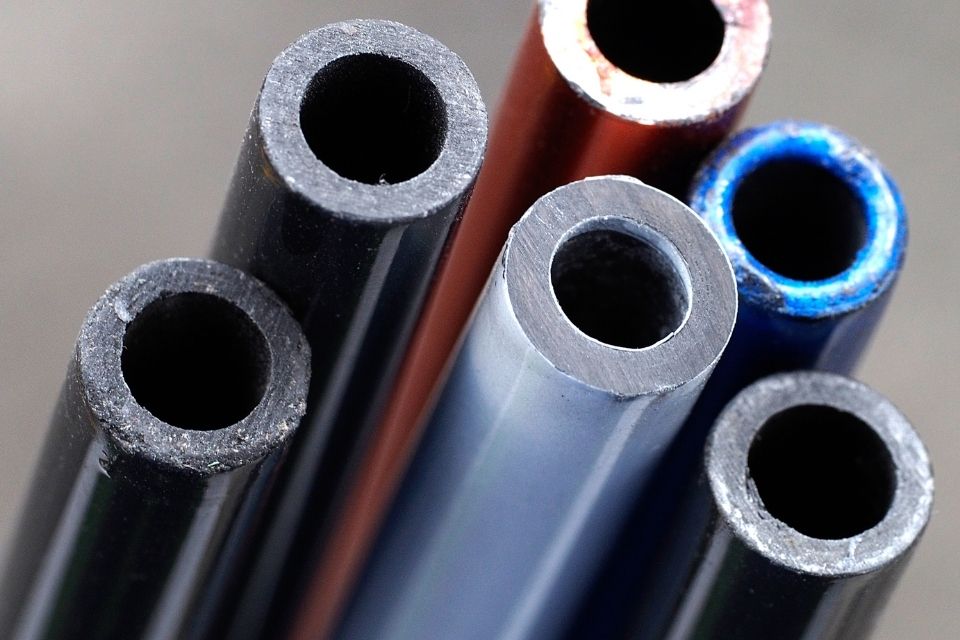
If you consider cutting the length down, there are several important factors you need to consider before you do the trim.
Changing the shaft length alters its flex and kick point, potentially making it stiffer and changing how it performs.
Shortening the shaft affects the club’s overall weight and balance, which can impact swing feel and performance, and reduces the club’s swingweight, potentially requiring weight to be added to the clubhead.
You’ll need to remove and reinstall the grip, which requires proper technique and materials.
Precise measurement is crucial when marking and cutting the shaft to ensure you achieve the desired length. Use a shaft cutter or fine-toothed hacksaw designed for graphite shafts to avoid splintering or damaging the material.
Be cautious not to cut from the tip end of the shaft, as this can significantly alter its performance characteristics.
Modifying your club may void any manufacturer’s warranty and you should ensure the modified club still conforms to golf regulations if you plan to use it in official play.
Shaft cutting is a delicate process that requires some expertise, so if you’re unsure, it’s often better to have a professional do it to avoid negatively impacting your driver’s performance and your game.
Final Thoughts
The shaft length of a golf driver is a critical factor that can significantly influence various aspects of a player’s game. From affecting swing speed and distance to impacting accuracy, ball flight, and overall consistency, the right shaft length can be a game-changer.
It plays a crucial role in shaping swing mechanics, boosting player confidence, and even adapting to different course conditions. Moreover, finding the optimal shaft length can help players work with their physical attributes or limitations, potentially enhancing their overall performance.
Given its far-reaching effects, golfers should carefully consider their driver’s shaft length, ideally seeking professional fitting advice to ensure they’re using equipment that best suits their individual needs and playing style. By doing so, players can optimize their driving performance and potentially elevate their entire golf game.
Similar Posts
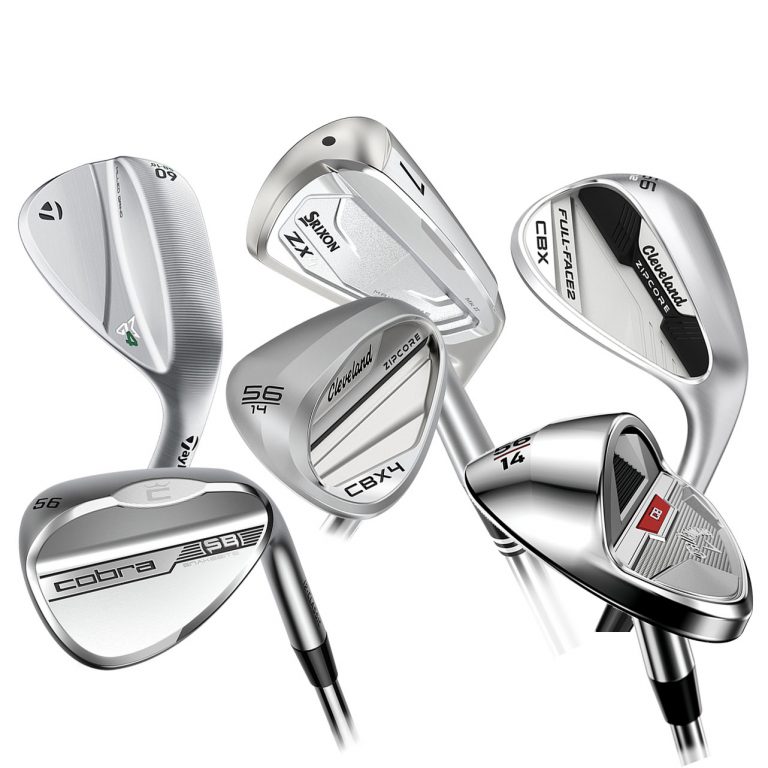
Understanding Clubs: The 4 Types Of Golf Wedges
Gap wedge GW or Approach Wedge AW Loft: 51-53 degrees Wedges are essential tools in a golfer’s arsenal…
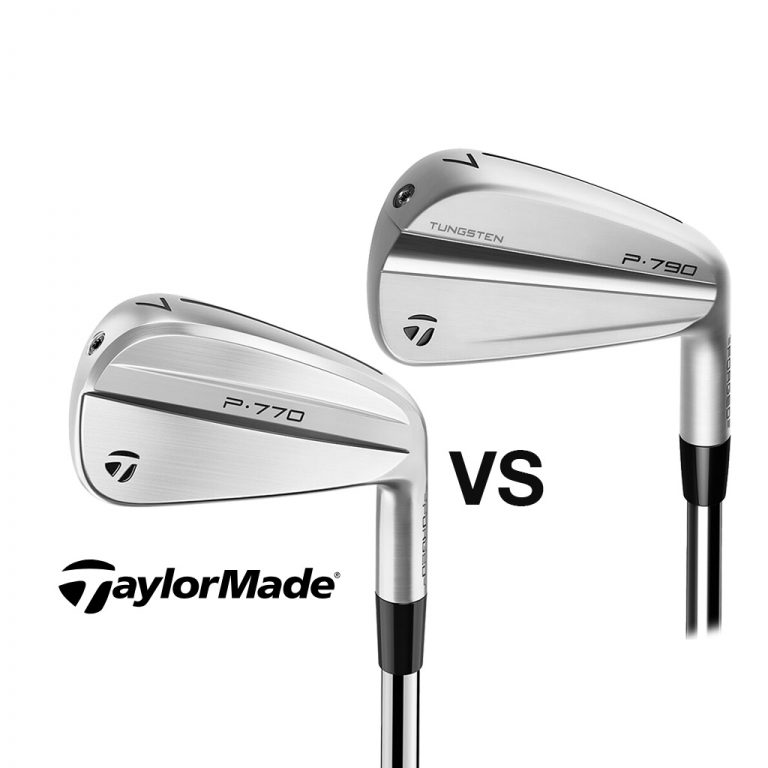
TaylorMade P•770 Vs P•790: What Are The Differences?
There’s more to golf than just being a perfect-pure ball striker. If you are in line to become…

Review: TaylorMade RBZ Speedlite for Men & Women
The TaylorMade RBZ SpeedLite golf set is designed to cater primarily to both men and women beginner and…

Forgiving Putters To Help You Putt Straight
This is our guide to the most forgiving putters. A forgiving putter can help you achieve a good…

Golf Club Grooves: What Are They And How Do They Help?
Have you ever looked at your irons and your wedges and noticed the grooves on the club? Chances…

3 Wood vs. 5 Wood: What Are The Differences?
A fairway wood is a club that all golfers need. I know that without a fairway wood in…
My question is if I remove my 45 inch stiff driver shaft and put a (same shaft) 48 inch does it change the flex (does now become a r or a shaft
By increasing the shaft length, you do change the flex of the club. A lot of times, you will change the flex by an unpredictable amount. By increasing the length of the shaft, you actually lower the bend point (or kick) of the shaft.
Players with a high swing speed will be able to notice this more than others, however even a player with a lower swing speed may feel they are not as accurate as before.
I hope this helps!
Thanks so much for your article!! I’m 70 with a short 100-150, but always straight shot. It’s actually boring and frustrating 😉 as I just can’t get the ball to go any farther. Am anxious to juggle the shaft length so it does not feel as unwieldy while still maintaining the straight flight.
Best Regards
I would say try out a longer shaft and see how it feels! It may be weird at first but you might be surprised by the result 🙂
Building a 7° driver 46 in I am 6ft hit my drives 200 220 straight light senior shaft
Leave a Reply Cancel reply
Your email address will not be published. Required fields are marked *
Save my name, email, and website in this browser for the next time I comment.

- Rex Hoggard ,

Trending Teams
Usga, r&a make local rule to cap pros’ driver length at 46 inches.
- Golf Channel Digital ,
- Golf Channel Digital
Golf’s governing bodies announced a new model local rule Tuesday that will reduce the maximum length of driver shafts from 48 to 46 inches.
The rule, which goes into effect Jan. 1, will allow the various tours the option to implement a local rule (MLR G-10) that will cap driver length at 46 inches.
This proposal was first announced in February and widely seen as a response to Bryson DeChambeau’s recent distance gains, though the USGA and R&A said that research into the topic first began in 2014. A proposal to limit the length of driver shafts was put forward in 2016 but shelved a year later once the governing bodies dove into the Distance Insights Project.
“Looking at the game and looking at the trends now of golfers at the highest level beginning to explore [lengthening] or lengthen their clubs, we thought the time was appropriate to go ahead and allow for a model local rule to be available that we only intend to be used at the highest level, so the professional tours or the elite amateur events,” Thomas Pagel, the USGA’s senior managing director of governance, told Golf Channel, before adding that the rule “is not going to impact any recreational golfer.”
Though DeChambeau experimented with a 48-inch driver in the run-up to the 2020 Masters, he opted not to put the club in play and typically uses a 45 ¾-inch model.
Few pros, in fact, use a driver that exceeds 46 inches in length. Pagel said the number is around 3% of pros. One of the exceptions is Phil Mickelson, the reigning PGA champion, who recently railed against the governing bodies’ decision:
Word is USGA is soon rolling back driver length to 46inches.This is PATHETIC.1st it promotes a shorter more violent swing (injury prone,) doesn’t allow for length of arc to create speed,and during our 1st golf boom in 40 years,our amateur gov body keeps trying to make it less fun — Phil Mickelson (@PhilMickelson) August 27, 2021
“We have taken time to consult fully with the golf industry, including players, the main professional tours and equipment manufacturers, and have considered their feedback carefully,” said R&A chief executive Martin Slumbers. “We believe this is the right thing for the game at this time and it will provide tournament organizers with the flexibility to choose for themselves within the framework of the rules.”
Added USGA CEO Mike Whan: “Admittedly, this is not the ‘answer’ to the overall distance debate/issue but rather a simple option for competitive events. It’s important to note that it is not a ‘Rule of Golf,’ and as such, it is not mandated for the average, recreational golfer. Rather, this is an available tool for those running competitive events.”
The PGA Tour chimed in later, telling GolfChannel.com this via statement that it planned to adopt the rule on Jan. 1.
“The PGA Tour collaborates with the USGA and R&A regularly on equipment matters, as well as with other industry stakeholders,” the statement read. “We have been aware of research in regard to limiting club length since 2014, and more recently the local rule proposed early in 2021 and announced today. After understanding the feedback received from the golf manufacturing community, we also undertook a survey of usage of clubs in use across the PGA Tour, PGA Tour Champions and the Korn Ferry Tour and found that a very small number of players either have used or are currently using clubs greater than 46 inches. The PGA Tour Player Advisory Council recently reviewed the subject and we have concluded that the PGA Tour will implement the Local Rule on January 1, 2022. The adoption of this Local Rule on Tour is consistent with other equipment rules changes we have supported since 2003.”
At the end of their release, the governing bodies said that research into golf-ball testing and tolerance of the spring-like effect is still under consideration.
“Again, this is not a solution, it’s not the solution to Distance Insights,” Pagel said. “We remain committed to the fact that we see distance long-term creating challenge for the game and we want to identify solutions so that the game can be just as healthy as it is today 20, 30, 50 years from now. … Let’s be proactive, and if we know that golfers have the ability to gain additional yardage by going to a longer club over time, let’s just cap it now.”

Golf Driver Shaft Length (Buying Guide)
Are you struggling to achieve the ideal ball flight and distance with your driver? The culprit may be the length of your driver shaft. Finding the optimum driver shaft length for your swing can have a significant impact on your performance on the golf course.
In this comprehensive guide, we’ll explore all aspects of driver shaft length, including how to measure it accurately, how your height can influence the ideal length, and the pros and cons of different lengths.
We’ll also take a closer look at the driver shaft length preferences of professional golfers on the PGA Tour.
So, whether you’re a beginner or an experienced player, read on to discover how to select the perfect driver shaft length for your game and take your driving distance and accuracy to the next level.
Resource: Golf Practice System with Step by Step Practice Plans + Video Lessons
How to Measure Driver Shaft Length
Measuring the length of your driver shaft accurately is crucial for achieving optimal performance on the course. Here’s a step-by-step guide on how to measure your driver shaft length:
- Place your driver on a flat surface, with the clubhead pointing towards you.
- Using a measuring tape, place the end of the tape at the center of the clubhead.
- Stretch the measuring tape along the shaft towards the grip.
- Stop at the end of the grip and take note of the measurement in inches.
It’s important to note that the length of your driver shaft can affect your swing and overall performance. A longer shaft can potentially increase distance, while a shorter shaft can enhance accuracy.
Consider the following tips and recommendations to help guide you in determining the best driver shaft length for your game:
- Visit a professional club fitter who can analyze your swing and recommend the appropriate driver shaft length for your specific needs.
- Use a driver shaft length calculator to determine the optimal length based on your height and swing characteristics.
- Experiment with different shaft lengths to see which one feels the most comfortable and allows you to perform at your best.
By following these guidelines and taking the time to ensure you have the correct driver shaft length, you can improve your golf game and enjoy greater success on the course.
Driver Shaft Length by Height
When it comes to selecting the right driver shaft length for your golf game, your height plays a significant role.
The ideal length of your driver shaft is dependent on your height as it can impact your swing and overall performance on the golf course.
While there is no hard and fast rule on driver shaft length by height , there are general guidelines that can help you make an informed decision.
The following driver shaft length chart by height provides a helpful starting point:
It’s important to note that this chart serves only as a guideline, and is not a definitive rule. Other factors such as swing speed, ball flight, and personal preference can also play a role in determining the best driver shaft length for you.
When it comes to club fitting, it’s best to work with a professional who can provide personalized recommendations based on your individual needs and goals.
By taking into consideration your height, swing, and other factors, a skilled professional can help you find the optimum driver shaft length for your game.
Pros and Cons of Different Driver Shaft Lengths
Choosing the right driver shaft length can have a significant impact on your golf game. However, both long and short driver shafts come with their own set of advantages and disadvantages. Here’s what you need to know:

Pros and Cons of a Long Driver Shaft Length
Long driver shafts can potentially increase your distance off the tee, but they can also be more difficult to control. Here are some pros and cons of a long driver shaft:
If you’re an experienced golfer with a faster swing speed, a longer driver shaft may be beneficial for you.
However, if you struggle with accuracy or have a slower swing speed, a longer shaft may not be the best option for your game.
Pros and Cons of a Short Driver Shaft Length
Shorter driver shafts can enhance your accuracy, but they may sacrifice some distance. Here are some pros and cons of a short driver shaft :
Consider your playing style and skill level when deciding on a driver shaft length.
If you struggle with accuracy or have a slower swing speed, a shorter shaft may be a better fit for your game. However, if you prioritize distance and have a faster swing speed, a longer shaft may be more suitable for you.
Remember, the ideal driver shaft length for you ultimately depends on your unique swing characteristics. It’s important to get fitted by a professional to ensure you have the correct length and other essential specifications for your driver.
By understanding the pros and cons of both long and short driver shafts, you can make an informed decision about which option may be best for your golf game.

PGA Tour Driver Shaft Lengths
Professional golfers on the PGA Tour have unique preferences when it comes to their driver shaft lengths.
While some players opt for longer shafts to increase their distance, others prefer shorter shafts for greater accuracy.
Interestingly, the average driver shaft length for PGA Tour players is around 44.5 inches, which is shorter than the standard length of 45.5 inches found in most off-the-rack drivers.
Several factors influence the driver shaft length choices of PGA Tour players, including swing speed, accuracy, and personal preference.
For example, Bryson DeChambeau, known for his powerful swing, uses a 45.5 inch shaft, while Tiger Woods, known for his accuracy and control, uses a shaft that is only 43.5 inches long.
Shorter Shaft Lengths
PGA Tour players who prefer shorter shafts typically value accuracy over distance. By using a shorter shaft, players can better control their ball flight and reduce their chances of hitting errant shots.
In addition to Tiger Woods, other PGA Tour players who use shorter shafts include Justin Thomas (43.5 inches), Collin Morikawa (43.25 inches), and Rory McIlroy (43.5 inches).
Longer Shaft Lengths
For PGA Tour players who prioritize distance, longer shafts can help achieve greater swing speed and ball velocity.
However, longer shafts may also increase the chances of mis-hits and reduce accuracy.
Bryson DeChambeau, who is known for his long drives, uses a 45.5 inch shaft. Other PGA Tour players who use longer shafts include Dustin Johnson (45 inches) and Phil Mickelson (45.5 inches).
It’s important to note that driver shaft length is just one of many factors that can influence a player’s performance on the course.
Each golfer has their unique playing style, swing, and strengths, so finding the right driver shaft length requires individual consideration and experimentation.
What is the importance of finding the right driver shaft length?
Finding the right driver shaft length is crucial for optimizing your golf game. The length of your driver shaft can greatly affect your swing and overall performance on the course. It can impact distance, accuracy, and control, so it’s essential to find the right fit.
How do I measure my driver shaft length?
To measure your driver shaft length, follow these steps: 1. Place the driver on a flat surface, ensuring it is properly aligned. 2. Use a measuring tape or ruler to measure from the sole of the club to the end of the grip, excluding the cap. 3. Ensure the measurement is accurate and take note of the length. 4. Alternatively, you can use a driver shaft length calculator for more precise measurements.
Does my height affect the ideal driver shaft length for me?
Yes, your height can influence the ideal driver shaft length for you. Generally, taller players may benefit from longer shafts, while shorter players may find shorter shafts more suitable. However, it’s important to consider other factors such as swing technique and personal preference as well.
What are the pros and cons of different driver shaft lengths?
The pros and cons of different driver shaft lengths include: – Longer Shaft: – Pros: Potential for increased distance due to increased clubhead speed. – Cons: Can be more challenging to control and may lead to less accuracy. – Shorter Shaft: – Pros: Improved control and accuracy, especially for those with a slower swing speed. – Cons: Potential for reduced distance due to decreased clubhead speed. Ultimately, the choice between longer and shorter shafts depends on your playing style and skill level.
What driver shaft lengths do professional golfers on the PGA Tour use?
Professional golfers on the PGA Tour have varying preferences for driver shaft lengths. Some players opt for longer shafts to maximize distance, while others prefer shorter shafts for improved accuracy. The choice of driver shaft length among professionals often depends on individual playing styles and personal preferences.
Golf Practice System for Lower Scores
Learn the exact golf practice routines thousands of students at Foy Golf Academy are using to lower their golf scores.
Follow these step by step practice plans and watch video lessons to learn how to improve your golf swing, chipping, and putting fundamentals.
Get access to hundreds of golf drills to practice as well as content on the mental side of golf, fitness plans, worksheets, and many more resources. This is a complete golf practice system.
Start Following These Practices —> Nick Foy Golf Practice System
Nick Foy, Instructor

*Some links on this page may contain affiliate links. Thank you for supporting me.
Don’t miss out
Breaking 90, 80, 70 golf practice plan.

The 15 Best Golf Drills that
Lowered my golf scores.
Sign up to get this resource + more helpful golf lessons to your inbox
Driver Length | Standard Shaft Length and If It's Right For You
Last Updated on July 24, 2021
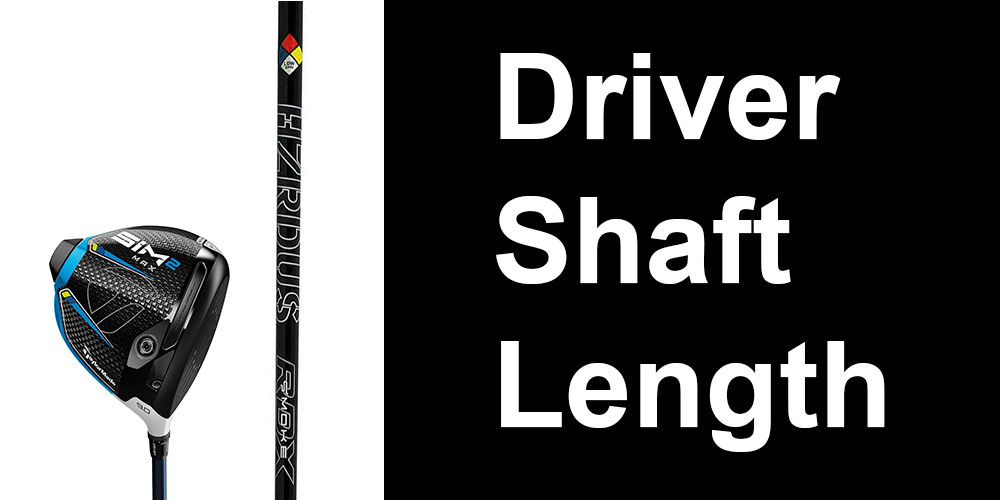
When hitting driver, we want to hit the ball as far as possible while keeping it in play.
Longer shafts typically lead to higher swing speeds and further drives, but at some point, an increase in distance no longer makes up for the loss in accuracy and consistency.
In this guide, we'll answer all the questions you have about driver lengths, including:
- What's the standard driver length?
- What length driver do the best club fitters recommend for most golfers?
- How long are PGA Professionals' drivers?
- How long should your driver be?
- Don't cut down a driver without making weight adjustments
- Making a case for a Driver and "2-Wood" in your bag
What's the Standard Driver Length
The standard driver length for men's clubs is 45.5" to 45.75" inches long. Because women tend to be shorter than men, the standard women's driver length is usually closer to 44".
The 2020 TaylorMade SIM2 , Callaway EPIC , PING G425, and Titleist TSi1 come configured at 45.75" off the rack.

Meanwhile, TaylorMade's SIM2 women's models are 43.75", and Callaway's women's EPIC drivers are 44.5".
As the size of driver's heads have increased over the years, so too have the length of their shafts. Thirty or more years ago, the standard shaft length for a driver was closer to what we see in 3-woods today, around 43 inches.
While the argument can be made that golf club manufacturers have pushed driver lengths too far so that they can advertise more distance, remember that clubs have gotten a lot more forgiving over the years.
What Length Driver Do the Best Club Fitters Recommend for Most Golfers?
In our experience getting fitted and what we've gathered talking to and researching what club fitters have to say about driver length, most of the best club fitters recommend drivers very close to the standard length for most golfers.
For example, the video below shows Ian Fraser of TXG Tour Experience Golf, one of the most well-respected club fitters in the industry, discussing how he fits most golfers at 45".
The average golfer will perform best with a driver at or near standard length. While exceptions are fairly rare, golfers who are significantly shorter or taller than average are most likely to benefit from a non-standard length shaft.
During a fitting, if all else has failed while attempting to build a driver a player can hit consistently, a fitter may then look at shortening the length of the club.
Golfers who are extremely consistent and accurate with standard length drivers may want to consider increasing their driver's length in search of more distance.
Keep in mind, golf clubs are limited to a max length of 48" under the rules of golf.
How Long Are PGA Tour Professionals' Drivers?
PGA Tour Professionals tend to play drivers between 44-46" in length. The vast majority of pros are in the 44.5" to 45.75" range from what we've been able to gather.
There are, of course, exceptions in both directions.
Rickie Fowler famously decided to go with just a 43.5" driver in 2017, a year in which he won the Honda Classic.
On the opposite end of the spectrum, Phil Mickelson had a 5.5° 47.9" driver in his bag alongside a 10.5° "2-wood" when he won the PGA Championship. Bomber Bryson Dechambeau has had all of his success using a driver around standard length, but he's been talking a lot about experimenting with a 48" driver.
How Long Should Your Driver Be?
As we mentioned at the start of this article, the best driver for you has the optimal balance of distance and accuracy.
It's not useful hitting 300+ yard bombs if every shot is out of bounds. You also don't want a driver that hits every fairway but leaves you a 3-wood approach into every par -4 hole.
The best way to find the correct driver is to get fitted by a knowledgeable club fitter. A good club fitter will not only let you try out all the different driver heads and shafts they have available, but also let you try varying length shafts.
If you're interested in trying a different length driver shaft, we'd recommend bringing this up with your fitter at the start of your fitting session. It may be a good idea to start by trying standard length configurations, as whatever problems you have with your current driver may have nothing to do with shaft length.
As we'll explain in further detail below, when the length of a shaft is changed, the club's swing weight will quickly change. A club fitter not accounting for this is a huge red flag.
Don't Cut Down a Driver Without Making Weight Adjustments.
Many golfers wanting to try a shorter driver think they can simply have their shaft cut down, but this is not the case if you want it to feel anything like a normal driver.
When you add or remove inches from a driver shaft without making any other adjustments to balance the weight of the club, the swing weight will change.
It doesn't take much for a driver to feel drastically different. 1/2 inch adjustments to a club's shaft length will move the swing weight by about 3 points. Cut a couple of inches off your men's driver shaft without adding weight to the head and it could easily feel like swinging a ladies iron. Trust us; this sounds better than in practice, especially as a golfer accustomed to heavier swing weights.
Again, a good club fitter should adjust the weight in the head, shaft, and/or grip for an optimal swing weight if you're straying too far from a standard configuration.
Making a Case for a Driver and "2-Wood" In Your Bag
It's starting to become popular having both a Driver and a "2-wood" in the bag.
We're huge fans of this trend, especially for golfers who don't struggle with distance off the tee.
If you decide to go this route, we love pushing the limits of your driver. For example, you may want to try extreme shaft lengths (standard length or longer), lofts (fast swinging players with a good driver swing can experiment with as little as 6°), and tee height (tee the ball up higher and try to swing up on the ball more).
With this bag setup, we're happy to lose a bit of driver accuracy in favor of distance. With another good par-4 and par-5 tee club in the bag, you only need to use this club when there's minimal danger if you hit offline.
The "2-wood" in this setup will be more of a "fairway finder." The goal is to minimize distance lost compared to your standard driver configuration while significantly tightening the dispersion of your shots. This club will generally have a shorter shaft and more loft .
There are a lot of options for the "2-wood" in this setup.
- Another Driver - If you can devote two clubs to being only used as tee clubs, you could use a higher lofted and/or shorter shafted regular driver head as a "2-wood".
- Mini-Drivers - TaylorMade's " Original One Mini Driver " has a standard length of 43.75", and it has a smaller head (275CC) at lofts of 11.5° and 13.5°. The loft can be adjusted by 2°, allowing it to go as low as 9.5°. Compared to a standard driver head, many golfers will find the TaylorMade Mini to be playable off the ground (depending on the loft).

- 3-Wood W/ Loft Turned Down - The final option is a low lofted 3-wood. Many manufacturers make 3-woods with lofts as low as 13° that can be adjusted by an additional 2° lower.
Final Thoughts
We've covered a lot in this guide, but ultimately it's on you to test out different clubs and find out what's right for you.
While a shorter or longer than standard driver is likely worth giving a shot, we'd first recommend trying different options close to standard length when getting fitted for a driver.
- Golf Terms Guide
- Golf Scoring Terms
- Best Golf Rangefinder
- What to Wear Golfing
- Terms of Service
- Privacy Policy
- Affiliate Disclosure

- Updated: December 16, 2022
Driver Shaft Length by Height
by Independent Golf Reviews
The average driver shaft length is about 45 1/2 inches because this is the standard driver shaft length you’ll find on clubs at your local golf store, so that is the length many recreational golfers use.
Of course, the shaft length can be shorter or longer, depending on player height and preferences.

Driver shaft Length by Height
There is no “one-size-fits-all” driver shaft. The right shaft length is different for everyone. The standard recommendation of how long a player’s driver shaft should be is based on the player’s height. More specifically, a wrist-to-floor measurement of the player can be used. Generally, the taller the player is, the longer the recommended shaft should be.
Height – Driver Length Fitting Chart
5’0″ to 5’2″ – 41.5 inches
5’2″ to 5’4″ – 42 inches
5’4″ to 5’6″ – 43 inches
5’6″ to 5’8″ – 43.5 inches
5’8″ to 5’10” – 44 inches
5’10” to 6’0″ – 44.5 inches
6’0″ to 6’2″ – 45 inches
6’2″ to 6’4″ – 45.5 inches
Over 6’4″ to 6’6″ – 46 inches
For example, the average shaft length you’ll find on drivers at your local golf shop (~45 1/2 inches) is a setup recommended for a player between 6’2″ and 6’4″. Certainly, only some people getting their new driver off the store rack and putting it right into their golf bag fall into that height range.
In fact, the average height of an American male is 5’9″, which equates to a recommended driver shaft length of 44 inches. That extra length will likely cause players to struggle to control their ball despite owning the latest and greatest driver technology.
According to our driver shaft length chart, a golfer that stands between 5’0″ and 5’2″ is recommended to use a driver shaft length of 41 1/2 inches. A golfer that is between 5’4″ and 5’6″ is recommended to use one that is 43 inches long. From there, every two inches taller a player is, the recommended driver shaft length increases by half an inch, with the last recommendation being 46 inches for players between 6’4″ and 6’6″. Wrist to floor measurements should also be taken because a person’s wingspan might cause them to fall into a different category than the one for their height.
Hitting the fairway in PGA Tour events is often more important than distance. The average driver length on the PGA Tour is 44 1/2 inches – a full inch shorter than the average stock driver. Many professionals prefer a shorter driver shaft, as it can help give them better control and accuracy. Of course, shaft lengths vary from player to player and often from course to course, as players look to maximize their performance each week by catering their game to each venue.
Pros and Cons of a Longer/Shorter Driver
The most basic battle a golfer faces is the balance between distance and accuracy. Hitting the ball farther is a goal for nearly all golfers, no matter the level. Distance is cool, while accuracy can become an afterthought. This is one of the reasons stores default to a shaft that is too long for the average player. A person using a shorter shaft will love that the ball is going farther when trying it out at the store.
The length of the driver shaft has an extreme impact on the distance, as a longer driver shaft helps to increase a player’s clubhead speed, leading to a faster ball speed. If you are a player that struggles to generate swing speed, a longer driver shaft may help gain some much-needed yardage off the tee. All that extra speed will help improve overall distance.

The extra length can also make the club more difficult to control, losing accuracy. If you’re a player that likes or needs to work the ball with a particular trajectory, a longer driver length could make that more difficult or less predictable.
Restrictions of Shaft Length in Professional Golf
In January 2022, golf’s governing bodies created a rule limiting how long a driver shaft can be, capping the length at 46 inches for high-level competition. Enforcing the rule would fall to the tournament itself, but this did cause some uproar amongst some of the game’s most prominent players.
Phil Mickelson, well known for his desire to chase distance, was greatly displeased by the rule, especially after he used a 47 1/2-inch driver to win the 2021 PGA Championship.
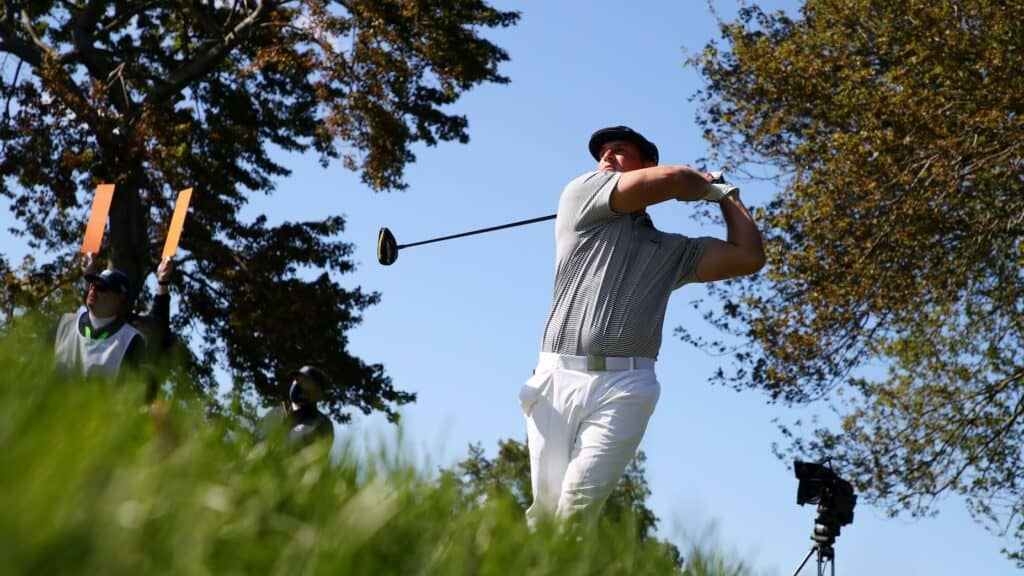
Bryson DeChambeau, who was among the longest drivers of the ball on the PGA Tour before departing for LIV Golf, leaves no stone unturned when seeking a distance advantage. He had been experimenting with a 48-inch driver before the rule was adopted.
The rule won’t affect the vast majority of golfers, though. According to the Rules of Golf, a driver shaft length up to 48 inches is still legal, so feel free to use the longer club when playing with friends.
What is Best For You?
Every player is different, both in physical traits and performance goals. In order to find the ideal shaft length, schedule a professional club fitting. They will get accurate height and wrist-to-floor measurements to get you started in the right direction and get the correct club length.
From there, a fitter can help determine exactly what kind of shaft will give you the best results. Driver length is important, as are shaft flex, shaft weight, and kick point. Whether you fit into a standard length or a shorter one, a fitter can match you to the specifications of a shaft that will help you hit the ball your best and be more consistent.
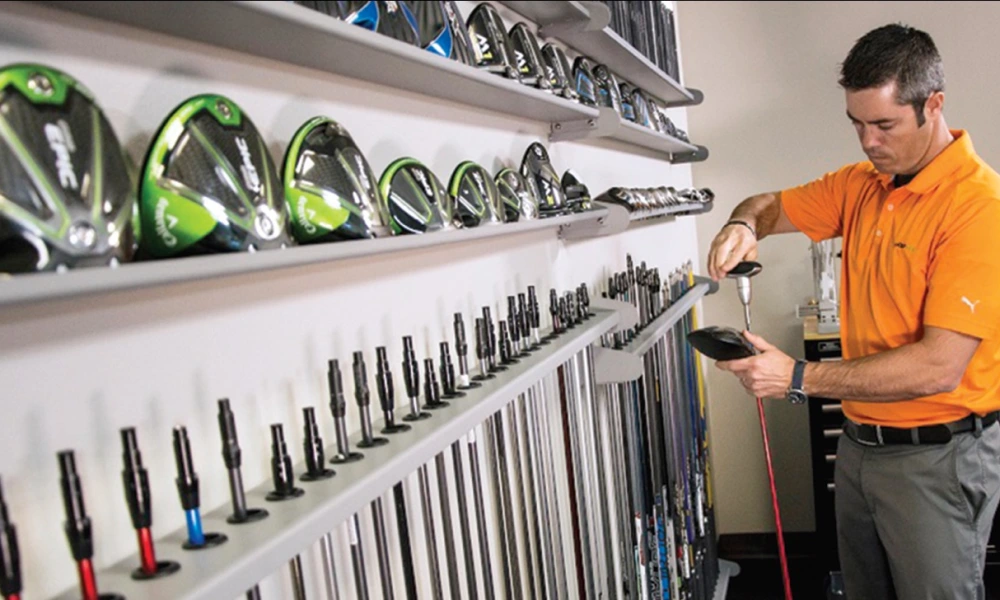
About The Author
Writers of Independent Golf Reviews Independent Golf Reviews has tested and reviewed 1000+ golf products over the past 10 years. We use our experience and expertise to give golfers an unbiased insight on the market. Read more…
You are now an official member of IGR. Keep an eye out for the perks.
No spam, ever. 🔒

About Us Submit Your Product Contact
Full Disclosure Privacy Policy Terms and Conditions
© 2024 Independent Golf Reviews

How Long Should Your Driver Shaft Be? All You Need to Know
Are you heading out to the pro shop to look at a new driver? Choosing the right shaft length for your Big Dog or fairway wood is critical to your swing and your experience with the club. You might find it surprising how much adding or taking away just a half-inch from the shaft length can make to your swing and shot.
Shaft length affects your accuracy and your distance off the tee. You’ve probably heard the saying that “golf is a game of inches,” which is true when it comes to your shots and driver shaft length. Any golfer will tell you that there’s nothing more satisfying than the feeling of connecting with the sweet spot and nailing a bomb right off the tee.
With each generation of equipment improving performance, feel, and forgiveness in clubs, you need a custom fit to get the most out of your equipment. You’ll get the consistency you need for your shots with the right shaft length, allowing for long, straight drives off the tee box.
So, what do you need to know about choosing the right shaft length for your new driver? Is your current driver setup to optimize your performance? This post unpacks everything you need to know about driver shaft lengths.
The Role of Driver Shaft Length in Distance and Accuracy
Some golfers are under the mistaken impression that the longer their shaft length, the further the drive. While this statement has some technical truth, it’s not entirely accurate. Opting for the longest shaft length you can find might not be the best strategy when selecting your new driver.
The reality is that longer shafts on drivers make it more challenging to control the club throughout the swing arc . This lack of control reduces distance and weaker accuracy in your drives.
However, several golfing brands claim that increasing your shaft length adds to better distance and accuracy – so, which one is it? Do you go for the longest shaft length available, or is there something to taking a measured approach to fitting your driver?
Sure, a longer shaft might help you get 15-yards extra out of your swing, but does that matter if you’re losing accuracy with your shots? Blasting the ball an extra ten yards deep into the rough or the sand trap isn’t really anything worth writing home about, right?

Driver Distance Sells Clubs
The truth is that advertising drivers that increase distance attract new drivers. If a brand is launching a new model, claiming that it adds to your distance is a great way to attract players desperate to increase their range off the tee box.
A longer shaft on your driver creates more clubhead speed – that’s a fact.
More clubhead speed equals faster ball speeds and better distance off the tee. For this reason, manufacturing brands continue to increase the shaft length on new models.
Somehow, brands find themselves locked in a game of “keeping up with the Jones” with shaft lengths. When one brand releases a new model with a longer shaft length, it’s not long before other brands rush to join the trend.
However, there has to be a point of diminishing returns when it comes to increasing shaft length, right? Or else, we would see brands offering clubs with ridiculous shaft lengths. The reality is that the longer the shaft length, the harder it is for the player to find the sweet spot consistently.
As a result, it’s more common for the player to make off-center contact with the clubhead. An off-center hit reduces distance and limits the accuracy of your shots. So, why would brands sell the longest shafts possible if there’s a chance that they’re actually decreasing your performance off the tee?
Golf brands usually go with the design that tests well. However, testing involves brands using robotic arms to create a consistent swing . A longer shaft could result in an extra five to ten yards on each shot when you have a consistent motorized swing.
However, it doesn’t work like that in real-world applications. You’re not a robot, and the dynamics of your swing could change due to a multitude of reasons. If you accidentally hit the toe of the clubhead, it could reduce your club speed and the ball speed by as much as eight to ten miles an hour. The result? Less distance and accuracy.
So, does that mean that a shorter shaft is the better option for your new driver? Well, not necessarily. While many golfers might find that dropping an inch or half an inch off their shaft length improves their performance, it’s not guaranteed.

What is a Standard Driver Shaft Length?
So, what is the right shaft length for your driver? What do the pros use? If you don’t have the skillset of a pro, what makes you think that a change in your driver shaft length will make any difference to your game?
According to professional fitters, it’s rare for them to build drivers with shaft lengths over 45″.
In fact, most fitters claim that beginner to intermediate golfers will do better with a shorter shaft length than the standard length offered by the manufacturer.
There’s a reason why the average driver shaft length on the PGA Tour is 44.5″, not 45.5″ or longer. Off the rack, the average driver shaft length measures 45.75″ with no customizations. For women, standard shaft lengths are between 43.75″ to 44.75″.
Of course, these are just averages. You might find several variations of up to 1″ in standard shaft lengths between manufacturing brands.
What Length Do I Need for My Driver Shaft?
So, what’s the right length of your driver shaft? Your height and wrist-to-floor measurements are critical to focus on when fitting your driver shaft. Taller players will require longer shafts and vice versa for shorter players.
However, there’s more to it than assessing your height and its impact on shaft length. Your posture also accounts for selecting the right shaft length, and that’s different for everyone. Factoring in your wrist height from the ground when addressing the ball will help you assess the right shaft length for your swing and playing style.
If you want to increase clubhead speed, longer shafts will help. If you’re looking to improve accuracy, it might be better to go with a shorter shaft. It’s challenging to recommend a specific length because every player has a unique style. There are so many factors accounting for the right shaft length for every player.
Your height, strength, and swing speed all factor into assessing the right driver shaft length. So, it’s a good idea to head to the pro shop for a fitting, and you won’t have to worry about the challenges of trying to do it yourself.
Choosing the Right Driver Shaft Length for Your Height
The key to selecting the right shaft length lies in understanding how shaft length and height affect the driver’s performance. As a general rule of thumb, taller golfers need a longer shaft for the driver and vice versa for shorter players.
Regardless of your height, you have the potential to drive the ball a long distance. Many short pros manage to get huge distances off the tee. It all comes down to the right fitment of your driver to your height and body mechanics.
For instance, ’91 Masters champion, Ian Woosnam, measures 5’4″, but his strength and clubhead speed allows him to drive huge distances. It’s about the fitment, not the player’s height or an extra-long shaft.
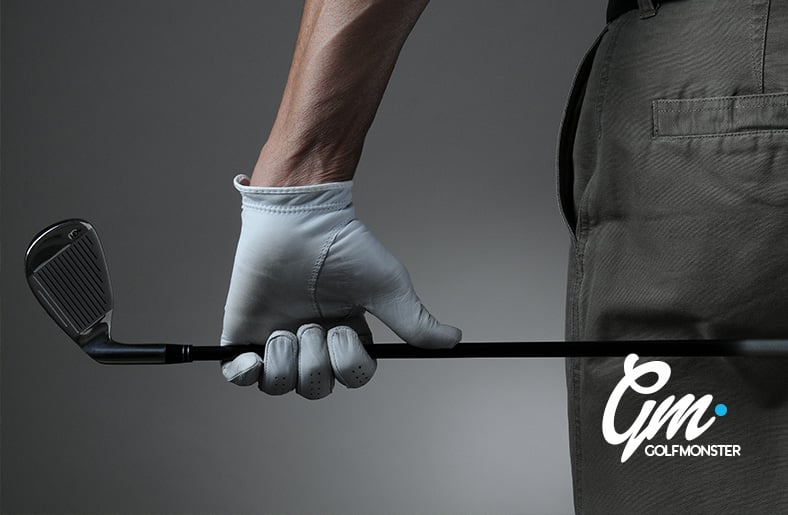
Do I Need to Shorten the Shaft Length of My Driver?
Are you wondering why your drive has gone to the dogs lately? Well, it could be your shaft length in the club. So, what can you do to improve your performance off the tee box? If you find that teeing off with your fairway woods gives you a better shot than the Big Dog, the problem is likely the shaft length on your driver.
The shorter shaft of the fairway wood makes it slightly easier to control the swing and the accuracy of your shot. If you’re struggling to hit the fairway with your driver, it might be worth removing some length from the shaft. The shorter length should make finding the sweet spot on the clubhead easier, increasing the contact and power in your drive while improving your accuracy.
If you’re worried about losing distance by shortening the shaft – don’t. Many golfers find they don’t lose any distance when shortening the shaft. They also improve their accuracy with the club. You might even find that you increase your reach by shortening the shaft, thanks to the enhanced control over the clubhead.
Before you decide to shorten or lengthen your driver shaft, it’s preferable to head to the pro shop and test a range of lengths to see which offers you the best performance off the tee. There are plenty of pro shops that let you try before you buy.
You’ll also find that many stores have attendants that help fit you to the right shaft length. Drivers aren’t cheap, and it’s the most expensive club in your bag. So, ensuring that you have the right setup gets you the most value for your budget and game.
What Is the Correct Method for Measuring Driver Shaft Length?
Measuring yourself for the correct driver shaft length isn’t as challenging as you think. You can do it yourself if you don’t have anyone around you, but it takes a little more time than if you have a helping hand.
Find a ruler or steel-fixed measuring tape with a minimum distance of 4-feet. The solid ruler is the better choice, but a steel measuring tape will do, provided you have something firm to measure against.
Hold your driver with the club head on the ground like you’re teeing up for a shot. Place the ruler or tape flush with the driver shaft, ensuring it’s perpendicular to the ground. Take your measurement and note it before heading off to the pro shop for a custom fitting.

Factoring in Wrist-to-Floor Measurements for Driver Shaft Lengths
The fitter will also account for the wrist-to-floor measurement when fitting you for your clubs. This measurement is the distance from your lower wrist on the grip, to the floor, in a perpendicular line.
They’ll use a chart to determine how this measurement affects driver shaft length according to your unique body type. Some people might have longer arms and shorter legs, or vice versa, so there is no one-size-fits-all, and each case is different.
While some players might think of a personal fitting as a luxury, it’s well worth the few bucks you pay when you consider its value to your game and your golf bag.

In Closing – Top Tips for Driver Fittings
Standard lengths are a myth.
Standard shaft lengths are a myth. The reality is there is no one-size-fits-all shaft length to suit all golfers. Every setup is unique and changes depending on your height, arm length, and other factors like hand-eye coordination and timing. So, it’s critical for you to visit a professional for fitting before you waste your money on purchasing the latest, longest driver.
Test It Before You Commit
Before changing your shaft length, it’s a good idea to visit a professional fitter. A fitter can help you assess the right shaft length to complement your swing. Fitters use digital tools like launch monitors, such as GC2, Trackman, or Flightscope, to determine the changes in your swing relating to shorting or lengthening the driver shaft.
Consider Before Your Cut
If you feel that your shaft is too long, take a minute to assess the situation before chopping off the length. Changing the shaft length alters your swing weight, resulting in a totally different feel to the driver. Shortening the shaft length by an inch is enough to require adjusting the clubhead to maintain the same club speed and ball speed. It’s critical to use a professional fitter when removing length from your clubs.

Casey hails from Florida & is our resident product tester and head of reviews here at GolfMonster. Casey is a scratch golfer with 20+ years of golf knowledge behind him. You will him out on the courses of Sarasota.
Related Posts
A to z of golf terms: a complete glossary of golf jargon, how many dimples are on a golf ball, best center shafted putter: our top choices & buyer’s guide, cobra radspeed king driver review: worth buying let’s find out, leave a reply cancel reply.
Save my name, email, and website in this browser for the next time I comment.
Type above and press Enter to search. Press Esc to cancel.
What Is The Optimum Driver Shaft Length?
GM technical editor Joel Tadman investigates the optimum driver shaft length for varying levels of player
- Sign up to Golf Monthly Newsletter Newsletter

Many Golf Monthly forum members are increasingly inquisitive over the distance gains we see on reader-fitting days, questioning where exactly the distance comes from. Many, erring on the cynical side, pinpoint an increase in shaft length as the predominant cause of the extra yardage. Others inquire as to why the shafts in tour players’ drivers are shorter than those offered at retail to amateur golfers.
Before I attempt to answer these valid questions, let’s provide some context. The maximum shaft length allowed by the Rules of Golf for competition is 48 inches and common thinking suggests the longer the shaft, the more clubhead speed you can create.
This is backed up by the fact two-time World Long Drive champion Joe Miller uses a 50in shaft. So if a longer shaft equals more distance, why doesn’t everyone use a maximum length 48in driver?
The answer comes down to control. In reality, the average length of a driver used on tour is 44.5in while the average shaft length found in drivers on the shop shelves is around 45.5in. There is an optimum driver shaft length with which golfers will achieve maximum clubhead speed and it will vary from player to player. The different length of stock shafts in drivers across manufacturers only reinforces the importance of a custom fitting .
Tiger Woods played a 43.5in shaft for many years and a number of the world's best play shorter shafts too. These players have above-average swing speeds and therefore do not need the distance an extra inch in their shaft would provide. They prioritise accuracy and control when configuring their driver set-ups. Ample distance comes naturally to them whereas for us comparable hackers, it does not.
So would the average 18-handicap golfer benefit from having a shorter driver shaft fitted? Well, yes and no. There’s no doubt that the majority of golfers would experience an increase in club speed in a 45.5in driver compared with a 44.5in driver and the testing that I have done backs up this theory. But for many, the trade-off is too severe.
For every half-inch of mishit on the clubface, you’ll lose five per cent of distance. So if a longer driver is too long for you to control, you’ll hit off-centre hits more frequently, often resulting in a drop in distance and accuracy rather than a rise.
Get the Golf Monthly Newsletter
Subscribe to the Golf Monthly newsletter to stay up to date with all the latest tour news, equipment news, reviews, head-to-heads and buyer’s guides from our team of experienced experts.
RELATED: Best golf drivers
Finding the centre of the face is the biggest ingredient to more distance. You could put a 47in shaft in your driver and your swing speed might increase by 5mph, but if you struggle to control the clubhead and frequently mis-strike the ball in the heel and toe, that extra club speed won’t necessarily translate into the ball speed needed to achieve more distance.

While some pros favour accuracy, others, like Phil Mickelson, prioritise the extra distance of a longer driver shaft
The only way to find out the ideal shaft length for your game is to hit shots on one of the best launch monitors and discover your club speed, ball speed, distance and dispersion with different lengths of shaft. If your swing speed increases with a longer shaft, but the ball speed remains unchanged, then the extra clubhead speed is useless and you’re giving up accuracy for no reason.
But before you march into your pro shop and demand the assistant lops an inch off the shaft in your current driver, remember that when you shorten any club you will reduce its swing weight and change the overall feel. So it’s not quite as simple as chopping it down. An experienced club-maker or a professional will be able to build in the requisite compensations into your clubs if you do decide to change the length of your driver.
RELATED: Which putter length should you use?
Every golfer is unique. Those with already fast swing-speeds are more likely to enjoy the control benefits of shorter shafts while higher handicappers with slower swing-speeds may be better off with the distance a longer shaft offers. It’s a balance and golfers prioritise areas of performance differently. Think about your own strengths and weaknesses and test out different lengths under the watchful eye of a pro before deciding.
Joel has worked in the golf industry for over 14 years covering both instruction and more recently equipment. He now oversees all equipment and video content at Golf Monthly, managing a team of talented and passionate writers and presenters in delivering the most thorough and accurate reviews, buying advice, comparisons and deals to help the reader or viewer find exactly what they are looking for.
One of his career highlights came when covering the 2012 Masters he got to play the sacred Augusta National course on the Monday after the tournament concluded, shooting a respectable 86 with just one par and four birdies. To date, his best ever round of golf is a 5-under 67 back in 2011. He currently plays his golf at Burghley Park Golf Club in Stamford, Lincs, with a handicap index of 2.8.
Joel's current What's In The Bag?
Driver: Titleist TSR3 , 9°, Fujikura Ventus Black 6 S shaft.
Fairway wood: Titleist TSR3 , 15°
Hybrid: Titleist TSi2 , 18°
Irons: Titleist T150, 4-PW
Wedges: Titleist Vokey SM10, 50°, 54° and 58°
Putter: LAB Golf DF3
Ball: 2023 Titleist Pro V1x

There are some surprising names who are heading home early after missing the cut at St Andrews
By Carly Frost Published 23 August 24

A frustrated Rory McIlroy reacted to a bad drive at the BMW Championship by tossing his club into the water
By Paul Higham Published 23 August 24

We take a look inside Graeme McDowell's 2010 US Open winning bag.
By Sam Tremlett Published 12 June 19

We take a look at the clubs Tiger Woods used during his momentous 2008 US Open win at Torrey Pines.
By Sam Tremlett Published 11 June 19

We take a look inside the bag of Angel Cabrera when he won the 2007 US Open at Oakmont Country Club.
By Sam Tremlett Published 24 May 19

Take a look inside the bag of Tiger Woods during his demolition of Pebble Beach back in 2000.

More images of Woods' new TW-Phase1 irons
By Elliott Heath Published 2 May 18

Check out what people said following Tiger's arrest on Monday
By Harry Shepherd Published 30 May 17

Adidas have sold all three of its golf brands to a US private equity firm
By Elliott Heath Published 11 May 17

The company have said that they will also stop making golf balls and bags
By Elliott Heath Published 3 August 16
- Contact Future's experts
- Terms and conditions
- Privacy policy
- Accessibility statement
- Cookies policy
- Advertise with us
Golf Monthly is part of Future plc, an international media group and leading digital publisher. Visit our corporate site . © Future Publishing Limited Quay House, The Ambury, Bath BA1 1UA. All rights reserved. England and Wales company registration number 2008885.

- Remember me Not recommended on shared computers
Forgot your password?
- WRX Club Techs
Driver length trends on PGA Tour

By jons1 June 22, 2020 in WRX Club Techs
- Reply to this topic
- Start new topic
Recommended Posts
I've always heard for years that the average driver length on the PGA Tour is 44.5". But looking at some of the more recent "What's in the bag" articles, it looks like driver lengths are creeping up, following the trends you see by OEMs. Here's a small sample of players:
Rory 45.6" long (who also plays irons +1/2" and he isn't that tall of a guy)
Web Simpson 45.25"
John Rahm 45.375" (who also plays irons +3/4" and he isn't that tall of a guy)
Justin Thomas 44 7/8"
Gary Wooldand 45.25"
Tony Finau 45.25" (though I think he cut it down to 44.75" more recently)
Dustin Johnson 45.75" !!!
Jordan Spieth 45.5"
Brooke Koepke 45"
Even Tiger Woods, which played some of his best golf with a steel shafted 43.5" driver, has tried as long as 45", but has since cut it back down to something like 44.5"
For every 1/2" you can, in theory, gain like 6 yards of distance... but that assumes you can swing with the same intensity and make perfect sweet spot contact and not change your spin due to angle of attack etc. So at the tour level, maybe I can see why the trend is to go longer than the previous tour average because of their consistent strike and smash factor. What's interesting is how specific some of these lengths are, as if they are trying to squeeze every 1/4" they can out of the club.
---------------- Golf Jobs Driver: Titleist TS3 9.5 w/ Tensei Blue 55 S 3W: Titleist 915F 15 w/ Diamana D+ 80 S 3H: Titleist 915H 21 w/ Diamana D+ 90 S Irons: 4-GW Titleist T100 w/ Project X LZ 6.0 Wedge: Vokey SM8 54.10S TC w/ Project X LZ 6.0
Wedge: Vokey SM8 60.04L TC w/ Project X LZ 6.0 Ball: 2021 Titleist ProV1
Link to comment
Share on other sites.
- Created 4 yr
- Last Reply 2 yr
Top Posters In This Topic

Popular Days
Stuart_G 7 posts
Titleist_PT23 7 posts
jons1 3 posts
Davidv 1 post
Jun 22 2020
Feb 25 2021
Mar 13 2021
Feb 24 2021
Popular Posts

third-times-a-charm
June 22, 2020
I know you guys have been dieing to know so I'll just say it...I play mine at 44.75"
I didn't have the time to look up more than 10 of the best players in the world, but after all, these are some of the best playing the game right now. Average assumes there are just as many shorter t
February 25, 2021
Jumping to conclusions. More data is always good but finding it to support a claim 8 months after it's made by some one else doesn't change what happened then.
No right answer people focus on what brings them the most enjoyment/satisfaction with the driver. So longer shaft, perhaps not as accurate but more distance, more fun for those who do not take the game too seriously.
In most cases, there is no distance gain at all. The smash factor goes down, and the golfer hits the ball the same distance or even shorter, in addition to being less accurate. So that seems pretty counter productive.
But it's interesting to see the trends on tour. Where lengths seemed to remain around 44 - 44.5" for many years, more recently the longer clubs are creeping their way into tour bags. I wonder if this is a result of trackman convincing players they are leaving too much on the table? After all, they would have the most consistent strikes imaginable, so if anyone would benefit it would be them.

DJGolfer001
i recently had my driver cut down to 44" and I have played my best ever off the tee. I hit the ball roughly 280y with driver and still consistently hit it 275-285 but its way more accurate.
I'd be careful about jumping to conclusions. That's a pretty small sample size to tell us anything about what the true trends really might be on tour.

Earlier this year i cut my driver down to 44 3/4" and like above, never have it better in my life.
Titleist GT3 10*
Titleist GT3 15* Callaway Apex 18*
Titleist T150 4-GW Titleist Vokey SM9 54* | 60*
Scotty Cameron Newport Classic
I know you guys have been dieing to know so I'll just say it...I play mine at 44.75"

AI TDMAX 10.5 + XC 6 / BLKOPS 4 W + 7 W & LIN Q 7+8 / 0317X 5H + GOST / FRGDTEC 5-P + MDUS 115 / JWS FRGD + MDUS 120 / PHNTM 7.5
Just to pile on, I’m playing at 44” and D6 head-weight. My SS did not drop a bit and I have never driven it better, distance and dispersion. Another thing for me is mentally with the shorter shaft in my hand I feel like I can really go after it when I need to and I don’t often get punished for it.
I didn't have the time to look up more than 10 of the best players in the world, but after all, these are some of the best playing the game right now. Average assumes there are just as many shorter than longer, and based on any lengths I've seen in WITB, doesn't look like too many players are playing under 44.5". If anything, more and more players are playing over 45", so I'd say the trend is upward.

My guess is that the OEM's wouldn't want them to be reporting shorter drivers...
TM SIM 10.5* - Ventus Velocore Blue TR 65S 44-1/4" TEE XCG7B 3h 19* Ventus Velocore HB Blue 8S TEE XCG7B 4h 22* Ventus Velocore Fujikura Speeder 904hb stiff TEE XCG7B 5h 25* Diamana Thump i465ct 4iron shaft Wishon 560MC 5-PW (26,30,34,38,42.5,47) Recoil Proto 125 F4 Vokey SM7 50-08F S200 bent to 51* Recoil Proto Wedge F4 Wishon HM wedges 56/60 Recoil Proto Wedge F4 2013-2016 SC Futura X5R 33' flownecked by Bastain-cerakote sniper gray-silver dots-white flange sight line-SS Flatso 2.0

PowderedToastMan
The idea that you automatically swing faster with a longer shaft just isn’t true. Each person has a point of diminishing returns. Could be 44” for one player and 46” for another.
Former professional golfer. Current amateur human being.
Driver: PXG 0811X Gen 4 7.5 HZRDUS Smoke iM10 Green 60 TX 45.9" D3
Driver 2: Taylormade Burner Mini 11.5 HZRDUS Smoke Green 70 X D5
Fairway: Taylormade Stealth Plus 3 Wood HZRDUS Smoke Green 70X D6
Hybrid: Taylormade Stealth 2 Plus 19.5 Tensei AV White 85 X D6
Irons: Sub70 659 MB 5-GW DG 105 X (Takomo 201's w/ occasional cameos)
Wedges: Titleist Vokey SM9 56 S Grind; Cleveland RTX Full Face 64 DG 120 X E0
Putter: PXG Battle Ready Raptor 38” Wristlock Grip

Jagpilotohio
thread number one million and one on this....?
For what it’s worth. I’m stubborn. 43.5” now for over 30 years. It’s works. I’m not changing it.
Im short with relatively long arms. Longer drivers are incredibly uncomfortable for Me. I feel like I’m swinging them unusually flat. I “swipe” at the ball.
My average distance actually goes down the longer I go. I just don’t make as powerful a swing or as consistently centered contact.
Still 113-115 mph at 53 so I’ll leave well enough alone. ?

RogerinNewZealand
The basics of any driver or fairway club rebuild.
A little shorter and heavier swingweight = control and in the Fairway.Some people just don't understand Fairways Hit Stat.
Stay In Play,enjoy your golf more !!
2020 18 July mid winterNZ Ping Rapture 2006 10.5 Nike VrS 3wood Callaway Razr Edge5 wood
MP100=33 9876 5/mp63 54 RTX2 60 RTX2 ProPlatinum NewportTwo 2002 325gram +8.NewGrip Dont hesitate to buy one!
Remember, that's an average. For an the long hitters that you picked, there are shorter hitters that may choose accuracy.
TaylorMade Qi10 9* driver
TaylorMade Stealth2 3 wood
TaylorMade Stealth2 5 wood
Adams tour proto 20 hybrid
Mizuno MP 223 (4-pw)
TaylorMade MG4 50/56tw wedges
Scotty putter
- 8 months later...
Titleist_PT23
On 6/22/2020 at 8:39 PM, Stuart_G said: I'd be careful about jumping to conclusions. That's a pretty small sample size to tell us anything about what the true trends really might be on tour.
Jumping to conclusions or preconceived notions?
PING - Pros - PGA Tour
11 hours ago, agolf1 said: Jumping to conclusions or preconceived notions?
Jumping to conclusions. More data is always good but finding it to support a claim 8 months after it's made by some one else doesn't change what happened then.
11 minutes ago, Stuart_G said: Jumping to conclusions. More data is always good but finding it to support a claim 8 months after it's made by some one else doesn't change what happened then.
So you think the tour average was 44.5 in June 2020?
20 minutes ago, Stuart_G said: Jumping to conclusions. More data is always good but finding it to support a claim 8 months after it's made by some one else doesn't change what happened then.
The following was posted by someone else in Oct 2019. It's only PING but it's better than nothing. There's also some comments from HJ in the thread. For people that were looking or paying attention, the data was there (not full tour data but pretty much the same stuff I found 8 months after the fact. If it was 8 months before the fact I guess it's still invalid too in your mind). But yeah, I guess it's jumping to conclusions.
look at what the men on Ping's staff are using, a couple are under 45" and the majority are longer then 45", with some using 46"+
28 minutes ago, agolf1 said: So you think the tour average was 44.5 in June 2020?
I didn't make any claim about what it might have been. I just suggested to someone else to find more data before coming to any conclusions about it.
32 minutes ago, Stuart_G said: I didn't make any claim about what it might have been. I just suggested to someone else to find more data before coming to any conclusions about it.
These were out in late-2019 and late-2020. Call it right or jump to conclusion, I guess either can be correct. But I am glad to know you were not questioning his claim at all, and just offering a data collection/research technique recommendation. It's just me but if I had known of the other data out there, I would point him in that direction. I.e. here's some more data but let's not jump to conclusions until we have more observations and can conclude with 99.9999% confidence that our sample mean is not over-stating the true mean of 44.5.
What's the average driver shaft length on the PGA Tour? Fully Equipped (golf.com)
Are long drivers here to stay? (pgatour.com)
I do realize it could all be due to changing player physique or measurement, as I learnt in the equipment thread.
8 minutes ago, agolf1 said: It's just me but if I had known of the other data out there, I would point him in that direction.
If I had known of other data, I would have. But it's not something I track or do research on - as you already know how much importance I put in those tour specs 🙂
6 minutes ago, Stuart_G said: If I had known of other data, I would have. But it's not something I track or do research on - as you already know how much importance I put in those tour specs 🙂
One interesting thought - If you regressed amateur hack's off the rack driver length and 7 wood usage (time T-5 or T-10) vs. PGA players driver length and 7 wood usage (time T) the stats may say the hacks are leading what the pros do! Hacks adopt longer driver before the pros realize its a good idea!
19 minutes ago, agolf1 said: One interesting thought - If you regressed amateur hack's off the rack driver length and 7 wood usage (time T-5 or T-10) vs. PGA players driver length and 7 wood usage (time T) the stats may say the hacks are leading what the pros do! Hacks adopt longer driver before the pros realize its a good idea!
I'd want to see some significant sales data before coming to any conclusions about what hacks really do or how that has trended over time - but if it really is happening, the reasoning isn't likely the same between the two groups. I believe that hacks would tend to use a 7 wood because they need the extra loft (and length) to help get the ball up into the air to improve distance and the longer length over the hybrids of similar loft increases club head speed. Pros don't have an issue with distance or getting the ball in the air, but rather can take advantage of the higher spin to increase the descent angle and decrease roll-out on approaches to the long par 5 holes.
4 minutes ago, Stuart_G said: I'd want to see some significant sales data before coming to any conclusions about what hacks really do or how that has trended over time - but if it really is happening, the reasoning isn't likely the same between the two groups. I believe that hacks would tend to use a 7 wood because they need the extra loft (and length) to help get the ball up into the air to improve distance and the longer length over the hybrids of similar loft increases club head speed. Pros don't have an issue with distance or getting the ball in the air, but rather can take advantage of the higher spin to increase the descent angle and decrease roll-out on approaches to the long par 5 holes.
Yes, I'm joking. There's a lot of quibbling about pga driver lengths. Then adjust that, adjust this, adjust something else. A simple regression would imply what I wrote but anyone with the lights turned on would realize X is not truly driving Y.
29 minutes ago, agolf1 said: A simple regression would imply what I wrote but anyone with the lights turned on would realize X is not truly driving Y.
Unfortunately there are a lot of people posting that don't have the lights turned on all the way. The relationship between correlation and causation is frequently misunderstood or misinterpreted.
shot-savior
I believe average driver length is increasing as a result of average shaft weight decreasing. The predominant driver shaft weight on tour is now in the 60 gram range. Just a few years ago anything under 70 grams was an outlier.
As we've gone from 130 grams of DG steel to 50 grams of AutoFlex we've gone from 43" to 47" in length.
After all the experimenting is done, driver length will find a suitable home.
- 3 weeks later...
According to TXG, average build length on tour as of May 2020 was 45.25. This is consistent with the data from Ping, where they actually list their pros specs. The trend has been increasing. It wasn't that long ago when the average was 44.5.
That said, the OEMs have always had longer standard lengths than tour builds. I think its because average golfers will hit it into the net and buy their driver based on the club that hits it longest. Not based on consistency.
didn't taylomade change the way they measure clubs recently so listed length is actually shorter using prior standard method? or did that not affect drivers?
Qi10 Core 9° | TZ Five 60 M4 Stealth+ 15° | TZ Five 70 M4 818H2 19° | Atmos HB TS Blue 8s
ZX5 MKII 4 - 6 | Modus 120s
ZX7 MKII 7 - PW | Modus 120s
RTX 6 Zipcore 50° | Modus 115w
X Forged 54.14, 58.10 | KBS Tour 125 Toulon Las Vegas | TP Mills Custom Trad II
justcallmemoses
32 minutes ago, JAY-Y said: didn't taylomade change the way they measure clubs recently so listed length is actually shorter using prior standard method? or did that not affect drivers?
TMs measured length is end of grip which is 1/8 of an inch I think. Titleist etc measurements are shaft cut so the grip butt cap adds an extra 1/8 to there published specs
Join the conversation
You can post now and register later. If you have an account, sign in now to post with your account.

× Pasted as rich text. Paste as plain text instead
Only 75 emoji are allowed.
× Your link has been automatically embedded. Display as a link instead
× Your previous content has been restored. Clear editor
× You cannot paste images directly. Upload or insert images from URL.
- Insert image from URL
- Submit Reply
Recently Browsing 0 members
- No registered users viewing this page.
2024 BMW Championship - Discussion and Links to Photos
GolfWRX_Spotted posted a topic in Tour and Pre-Release Equipment , August 20

2024 Albertsons Boise Open - Discussion and Links to Photos
GolfWRX_Spotted posted a topic in Tour and Pre-Release Equipment , August 19

2024 FedEx St Jude - Discussion and Links to the Photos
GolfWRX_Spotted posted a topic in Tour and Pre-Release Equipment , August 12

2024 Wyndham Championship - Discussion and Links to Photos
GolfWRX_Spotted posted a topic in Tour and Pre-Release Equipment , August 5

2024 Utah Championship - Discussion and Links to Photos
GolfWRX_Spotted posted a topic in Tour and Pre-Release Equipment , July 29
Popular Now
By playit Started 4 hours ago
By tonyj5 Started 9 hours ago
By Chris Beer Started Yesterday at 01:53 AM

By knudson81 Started August 12
By PSUJJH86 Started June 18
Welcome. Register Here.
Come on in, the water is fine...
Recent B/S/T

Shipwreck · Started 54 minutes ago
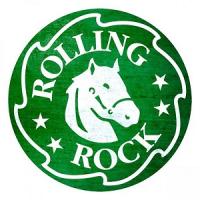
rollingrock · Started 1 hour ago
mr.haha · Started 1 hour ago
Whatnogarnish · Started 3 hours ago

Back9 · Started 3 hours ago
knudson81 · Started July 31

GolfWRX_Spotted · Started June 3
- Existing user? Sign In
The Bag Room
- Tour & Pre-Release Equipment
- Golf Sims/GPS/RFs/Apps
- Golf Style and Accessories
The Club House
- General Golf Talk
- Classic Golf And Golfers
- Courses, Memberships and Travel
- Groups, Tourneys, and Partners Matching
WRX Academy
- Instruction & Academy
- Rules of Golf and Etiquette
- Swing Videos and Comments
Classifieds & ProShops
- Deal/No Deal
Website Help
- Forum Support
- BST AD Help Forum
My Activity Streams
- BST/Deal Activity
- All Activity
- Unread - No BST/19th
- Subscriptions
Classifieds
- For Sale Forum
- Wanted to Buy
- Mall of Pro Shops
- Where Did My Ad Go?
- Trade In Tool
- Create New...

IMAGES
COMMENTS
The average driver shaft length on Tour is roughly 44.75 inches, give or take a half-inch in either direction depending on preference. Contrary to what some might think, there isn't a run on ...
After being properly weighted in the Titleist Tour Truck, the duo took to the practice range at the U.S. Open to conduct testing. With his previous 45-inch TSi3 driver setup, Smith was struggling ...
Take a closer look at the detailed driver specs for the PGA Tour's driving distance leaders from 2015 to 2019. x. ... every driver is different, from the shaft length down to the swing weight.
Key Takeaways. The average driver shaft length on the PGA Tour is approximately 44.75 inches. Longer shafts are not necessarily used to chase more distance, as drivers are already optimized for maximum yardage. Player preference plays a significant role in determining the driver length, with some variations observed among professionals.
When it comes to driver shaft length, PGA Tour professionals typically use drivers between 44-46 inches long. This standard length allows for a good balance between swing speed and control. However, some players deviate from this norm, such as Rickie Fowler and Phil Mickelson, who prefer drivers with different lengths than the norm. ...
During a past Golf Digest Hot List summit, we conducted a test with a multiple-time winner on the PGA Tour who hit tee shots with drivers measuring 44, 46 and 48 inches. The best results in ...
And yeah, Phil Mickelson won the 2021 PGA Championship with a driver measuring 47.9 inches. But as the PGA Tour discovered in its recent research on the matter of driver length, only 3 percent of ...
Most driver shafts were around 43 inches until the early 1990s. The stock standard now is anywhere from 45.5 to 46.75 inches. There are two reasons for that growth. First, driver head size has increased significantly. Put a bigger head on the same length shaft you're used to and it looks huge because your eye isn't used to it, so shafts ...
The PGA Tour said Tuesday that it would adopt a new local rule, effective Jan. 1, 2022, that would allow high-level tournaments to limit driver length to 46 inches.
It was typical in the 1990s for drivers played on tour to be in the 43-inch range, and now the majority of tour players use a driver between 44.5 and 45.5 inches.
38.00″ to 42.00″. 45.5″. 6′ 4″ - 6′ 6″. 38.25″ to 43.50″. 46.0″. The wrist-to-floor measurement is a crucial factor in determining the ideal golf club length for a player. This measurement helps ensure that the club isn't excessively long or short, as improper length can significantly hinder a golfer's performance.
Published October 12, 2021 01:00 PM. Golf's governing bodies announced a new model local rule Tuesday that will reduce the maximum length of driver shafts from 48 to 46 inches. The rule, which goes into effect Jan. 1, will allow the various tours the option to implement a local rule (MLR G-10) that will cap driver length at 46 inches.
That desire is there whether you're an amateur, or a PGA Tour player like Tiger Woods, Rory McIlroy, or Rickie Fowler. One way to achieve this is by lengthening a driver's shaft. Crucially, while the ball does go farther with a longer driver shaft, other details can also affect driver distance. ... Most golf pros have driver shaft lengths ...
Interestingly, the average driver shaft length for PGA Tour players is around 44.5 inches, which is shorter than the standard length of 45.5 inches found in most off-the-rack drivers. Several factors influence the driver shaft length choices of PGA Tour players, including swing speed, accuracy, and personal preference.
Thirty or more years ago, the standard shaft length for a driver was closer to what we see in 3-woods today, around 43 inches. ... How Long Are PGA Tour Professionals' Drivers? PGA Tour Professionals tend to play drivers between 44-46" in length. The vast majority of pros are in the 44.5" to 45.75" range from what we've been able to gather.
Hitting the fairway in PGA Tour events is often more important than distance. The average driver length on the PGA Tour is 44 1/2 inches - a full inch shorter than the average stock driver. Many professionals prefer a shorter driver shaft, as it can help give them better control and accuracy.
Mickelson, ever an equipment tinkerer, has toyed with various driver lengths. When he won the PGA Championship earlier this year, he had a 47.9-inch driver shaft in his bag. Under the soon-to-be ...
There's a reason why the average driver shaft length on the PGA Tour is 44.5″, not 45.5″ or longer. Off the rack, the average driver shaft length measures 45.75″ with no customizations. For women, standard shaft lengths are between 43.75″ to 44.75″. Of course, these are just averages.
The answer comes down to control. In reality, the average length of a driver used on tour is 44.5in while the average shaft length found in drivers on the shop shelves is around 45.5in. There is an optimum driver shaft length with which golfers will achieve maximum clubhead speed and it will vary from player to player.
The predominant driver shaft weight on tour is now in the 60 gram range. Just a few years ago anything under 70 grams was an outlier. As we've gone from 130 grams of DG steel to 50 grams of AutoFlex we've gone from 43" to 47" in length.
Schedule PGA Tour 2023-2024. Shows. ... And before you have a couple inches chopped off your driver shaft in the name of finding fairways, just remember that cutting those inches can recalibrate ...
Yes. There's tons of videos on this. Shorter driver shaft - similar length but better dispersion. Yes, and also no. Some guys are down to 44.5 and some up to 46z. Tiger Woods 43.5 inches, Sergio 43, Fowler 43.5, Bubba Watson 44.5. PGA Tour average (4 years ago) was 44.5. off the shelf drivers usually 45.5 or 46 inches.